Energy Trade in South AsiaCountries are shifting to using green energy sources to meet their energy needs and cut emissions. While South Asia may have ample renewable energy and hydropower resources, demand exceeds local supply, and the countries have had to rely heavily on imports. To help improve energy security in the region, South Asian countries have signed bilateral and multilateral agreements to trade energy, including India-Nepal hydropower projects and the India-Bhutan hydroelectric joint venture. Author: CUTS International Year: 2023 Download Tags: Energy, Trade, South Asia, Hydropower, Bhutan, India, Nepal  Expanding Opportunities: Toward Inclusive GrowthGDP in South Asia is estimated to grow at 5.6% in fiscal year FY2023 and 5.9% in FY2024, backed by the recovery in services and lower commodity prices. GDP growth in Bangladesh will decelerate to 5.2% in FY2022-2023 due to global economic uncertainty, before recovering to 6.2% in FY2024. In Bhutan, GDP is projected to expand at 4.5% in FY2022-2023 as the further reopening of borders support growth in industry and services. GDP growth in India will moderate to 6.3% in FY2023-2024 following slower growth in consumption. Maldives is seeing a return to the tourism sector's pre-pandemic levels with GDP growth projections in FY2023 at 6.6%. Growth in Nepal will slow to 4.1% in FY2023 following import restrictions, before rising to 4.9% in FY2024. In Sri Lanka, amid fiscal and external imbalances, GDP growth is estimated at -4.3% in FY2023 and 1.2% FY2024. In Southeast Asia, the Myanmar Economic Monitor projects Myanmar's economic recovery accelerating to 3% in the year to September 2023 following growth in industry and services. Author: World Bank Year: 2023 Download Tags: WB, Bangladesh, Bhutan, Sri Lanka, Services, India, Maldives, Myanmar, Nepal Basic Statistics 2023Basic Statistics presents data on development indicators tracking progress toward the Sustainable Development Goals. The publication includes new data for development indicators for 46 economies in Asia and the Pacific, including those for the seven South Asia Subregional Economic Cooperation countries: Bangladesh, Bhutan, India, Maldives, Myanmar, Nepal, and Sri Lanka. Author: Asian Development Bank Year: 2023 Download Tags: Bangladesh, Bhutan, India, Myanmar, Maldives, Nepal, Sri Lanka, Sustainable Development Goals 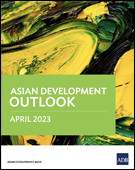 Asian Development Outlook (ADO) April 2023South Asia is projected to grow faster than other subregions in Asia, with real gross domestic product (GDP) estimated at 5.5% in fiscal year (FY) 2023 and 6.1 in FY2024. Growth within South Asia is expected to vary, with India projected to grow by 6.4% in FY2023 and 6.7% in FY2024 behind strong domestic demand. In Bangladesh, GDP growth is estimated at 5.3% in FY2023 owing to global economic disruptions and 6.5% in FY2024. In Bhutan, hydropower production will push up growth to 4.6% in FY2023 and 4.2% in FY2024. Growth in Maldives is estimated at 7.1% in FY2023 and 6.9% in FY2024, supported by a boom in tourism and construction. In Nepal, growth will slow to 4.1% this year before picking up in FY2024 at 5.0% with a recovery in tourism and infrastructure. Sri Lanka is projected to contract at -3.0% in FY2023 before recovering to 1.3% in FY2024 premised on debt relief and key reforms. In Southeast Asia, Myanmar's GDP will rise moderately to 2.8% in FY2023 and 3.2% in FY2024. Author: Asian Development Bank Year: 2023 Download Tags: South Asia, Hydropower, ADB, Bangladesh, Bhutan, India, Maldives, Myanmar, Nepal, Sri Lanka Identifying Challenges and Improving Trade Facilitation in the States of Northeast IndiaThe northeast of India is shares international borders with Bangladesh, Bhutan, Nepal, and Myanmar and acts as a bridge for India's participation in global forums through the Bay of Bengal Initiative for Multisectoral Technical and Economic Cooperation and the South Asia Subregional Economic Cooperation program. This paper highlights challenges in global trade and suggests ways for improving trade with other countries in South Asia and Southeast Asia. Author: Sanchita Basu Das and Soumya Chattopadhyay Year: 2023 Download Tags: India, Trade Facilitation, SASEC, BIMSTEC, Transport, Bangladesh, Bhutan, Nepal, Myanmar Significance of Padma Bridge in South Asia's ConnectivityThe Padma Bridge will improve connectivity and increase trade in the Bangladesh. The bridge increases connectivity in Bangladesh and is projected to improve the quality of life among nearby communities. The economies of nearby countries also stand to benefit, as the bridge improves connectivity among Bhutan, India, and Nepal, and improves mobility of people, goods, and essential services. Author: CUTS International Year: 2022 Download Tags: Transport, Trade, BBIN, Bangladesh, Bhutan, India, Nepal 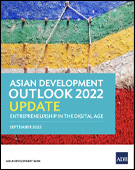 Asian Development Outlook (ADO) 2022 Update: Entrepreneurship in the Digital AgeGrowth forecast in South Asia is projected at 6.5% in fiscal year (FY) 2022 and FY2023. In Bangladesh, gross domestic product (GDP) growth is projected at 7.2% in FY2022 and 6.6% in FY2023, reflecting lower consumption spending. Growth in Bhutan is forecast to grow at 4.5% in FY2022 and 4.0% in FY2023 as government investment continues as a key driver of growth. In India, weaker than expected global demand is expected to affect growth, projected at 7.0% for FY2022 and 7.2% for FY2023. GDP growth in Maldives is forecast at 8.2% in FY2022 and 10.4% in FY2023 with continued tourism arrivals. In Nepal, GDP is projected at 5.8% in FY2022 and 4.7% in FY2023, affected in part by needed policy tightening to address rapid rise in imports. Contractions are projected for Sri Lanka, -8.8% in FY2022 and -3.3% in FY2023, likely resulting from severe macroeconomic challenges, including the impact of the ongoing crisis. In Southeast Asia, Myanmar's GDP is forecast at 2.0% in FY2022 and 2.6% in FY2023 owing to an improvement in economic activity. Author: Asian Development Bank Year: 2022 Download Tags: ADB, Bangladesh, Bhutan, India, Maldives, Myanmar, Nepal  Reshaping Norms: A New Way ForwardSouth Asian countries are emerging from coronavirus (COVID-19) pandemic burdened by high inflation and fiscal imbalances, as well as external shocks. In Bangladesh, gross domestic product (GDP) is projected to increase by 6.4% in fiscal year (FY) 2021-2022 and 6.7% in FY2022-2023. In Bhutan, FY2021-2022 growth is estimated at 4.4% and FY2022-2023 growth at 4.7%, with the expected return of international tourists and migrant workers from India. In India, FY2022-2023 growth is projected at 8%, slightly below last year’s rate. Economic recovery in Maldives will stay strong in 2022, with real GDP growth expected to grow by 8.5% in 2022 and 9.1% in 2023. In Nepal, tourism has yet to recover, with growth projected at 3.7% in FY2021-2022 and 4.1% in FY2022-2023. Hydropower in Nepal is providing a natural hedge against increases in crude oil-based energy prices. Growth in Sri Lanka is hampered by a series of shocks amid high debt, with 2022 growth projected at 2.4%. Author: World Bank Year: 2022 Download Tags: WB, South Asia, Bangladesh, Bhutan, India, Maldives, Nepal, Sri Lanka Basic Statistics 2022Basic Statistics presents economic, environmental, and social indicators used to track progress toward the Sustainable Development Goals. The publication includes new data for development indicators for 46 economies in Asia and Pacific, including those for the seven South Asia Subregional Economic Cooperation countries: Bangladesh, Bhutan, India, Maldives, Myanmar, Nepal, and Sri Lanka. Author: Asian Development Bank Year: 2022 Download Tags: Bangladesh, Bhutan, India, Maldives, Myanmar, Nepal, Sri Lanka, Trade, Sustainable Development Goals, Renewable Energy 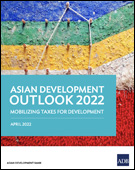 Asian Development Outlook (ADO) 2022: Mobilizing Taxes for DevelopmentGrowth in South Asia is projected to remain strong at 7.0% in FY2022 and 7.4% in FY2023 as the region’s economies try to catch up to pre-pandemic levels. In Bangladesh gross domestic product (GDP) growth is projected at 6.9% in FY2022. Growth in FY2023, projected at 7.1%, will be driven by private consumption. Bhutan is forecast to grow at 4.5% in FY2022. Growth will accelerate to 7.5% in FY2023 with the reopening of international tourism in the country. India is forecast to grow at 7.5% in FY2022 and 8.0% in FY2023, buoyed by strong investment growth. GDP growth in Maldives is forecast at 11.0% in FY2022 and 12.0% in FY2023 with continued tourism arrivals. In Nepal, fiscal stimulus and wider vaccination coverage will support growth, projected at 3.9% in FY2022 and 5.0% in FY2023. Sri Lanka's growth is forecast to slow to 2.4% in FY2022 and pick up to 2.5% in FY2023 amid low foreign exchange reserves. In Southeast Asia, Myanmar’s economy is forecast to contract in FY 2022 on protracted political instability. Myanmar GDP is forecast at -0.3% in FY2022 and 2.6% in FY2023. Author: Asian Development Bank Year: 2022 Download Tags: ADB, Bangladesh, Bhutan, India, Nepal, Sri Lanka, Maldives, Myanmar Field Diary Phuentsholing: Largest Commercial Hub in BhutanThis study assesses infrastructure and trade logistics in Phuentsholing, Bhutan. It observed that several South Asia Subregional Economic Cooperation (SASEC) projects have helped develop trade and transport in Phuentsholing through the construction of four-lane roads and bridges. The study proposes ways to promote multimodal connectivity among the BBIN countries (Bangladesh, Bhutan, India, and Nepal), such as the further improvement of ports and related facilities in Phuentsholing to handle an increase in trade and transport. Author: CUTS International Year: 2021 Download Tags: Bhutan, SASEC, Trade, Transport, BBIN Asian Development Outlook 2021 UpdateEconomic growth in South Asia is projected at 8.8% in 2021 while the outlook for next year has been raised to 7.0% from 6.6%. In Bangladesh, growth in fiscal year (FY) 2022 is projected to strengthen though still below pre-coronavirus pandemic levels. In Bhutan, gross domestic product (GDP) in FY2021 is estimated to have contracted by 3.4%; growth is forecast to rebound to 3.7% in FY2022. The projection for India is downgraded to 10.0% from the earlier projection of 11.0% in FY2021, while the outlook for FY2022 improved to 7.5% from 7.0%. Tourist arrivals in Maldives increased by 33.4% year on year in 2021. In Nepal, GDP growth is estimated at 2.3% in FY2021. In Sri Lanka, GDP growth forecasts are revised down to 3.4% in 2021 with risks from fresh pandemic outbreak and currency related stress. Author: Asian Development Bank Year: 2021 Download Tags: ADB, COVID-19, South Asia, Bangladesh, Bhutan, India, Maldives, Sri Lanka Basic Statistics 2021Basic Statistics 2021 presents development indicators—tracking the progress made by countries in achieving the Sustainable Development Goals. It includes data for 46 economies in Asia and the Pacific, including those for the seven South Asia Subregional Economic Cooperation countries: Bangladesh, Bhutan, India, Maldives, Myanmar, Nepal, and Sri Lanka. Author: Asian Development Bank Year: 2021 Download Tags: Bangladesh, Bhutan, India, Maldives, Myanmar, Nepal, Sri Lanka, Trade, Sustainable Development Goals, Renewable Energy Assam as India's Gateway to ASEANAssam's location in northeast India offers opportunities for enhancing cross-border trade and developing regional economic corridors spanning Bangladesh, Bhutan, India, Nepal, and countries in Southeast Asia. By developing trade and economic corridors, Assam aims to build on its vision of becoming a $75 billion economy by 2025. Author: Asian Development Bank Year: 2021 Download Tags: ASEAN, Bangladesh, Bhutan, India, Nepal, Regional Cooperation, Trade, ADB RCI Harnessing Inland Waterways for Inclusive Trade Among Bay of Bengal CountriesThe transboundary rivers Ganges, Brahmaputra, and Meghna create a vibrant water grid connecting Bangladesh, Bhutan, India, and Nepal. India has been developing fairways and river and multimodal terminals in the last few years. Further development of inland waterways in Bay of Bengal countries would create jobs and open opportunities for inclusive trade. Author: Veena Vidyadharan Year: 2021 Download Tags: Bangladesh, Bhutan, India, Inland Waterways, Nepal, Trade, Transport 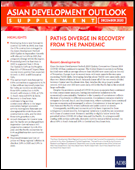 Asian Development Outlook (ADO) 2020 Supplement: Paths Diverge in Recovery from the PandemicThis publication provides updated economic forecasts for Asia and the Pacific. In South Asia, the earlier forecast of 6.8% contraction in 2020 is upgraded to 6.1%. Growth in South Asia is expected to return in 2021 at 7.2%. This is in line with improved prospects for India, where contraction is projected at 8.0% in 2020 and growth is projected at 8.0% in 2021. In Bangladesh, growth in exports and remittances backed economic activity. In Bhutan, the impact of the coronavirus disease (COVID-19) pandemic is expected to be greater than projected. Travel demand remains weak in Maldives and is hampering recovery. In Nepal, a persistent rise in COVID-19 infections holds back demand. Resurgent outbreaks in Sri Lanka’s export and tourist markets are expected to worsen contraction in 2020. Author: Asian Development Bank Year: 2020 Download Tags: South Asia, India, Bhutan, Sri Lanka, Nepal, Bangladesh, Maldives, Tourism, COVID-19, Export Basic Statistics 2020Basic Statistics presents select economic, environmental, and social indicators used to track progress toward the Sustainable Development Goals. It includes new data for development indicators for 46 economies in the Asia and Pacific region, including those for the seven South Asia Subregional Economic Cooperation countries: Bangladesh, Bhutan, India, Maldives, Myanmar, Nepal, and Sri Lanka. Author: Asian Development Bank Year: 2020 Download Tags: Sustainable Development Goals, Bangladesh, Bhutan, India, Maldives, Myanmar, Nepal, Sri Lanka Role of Multi-modal Connectivity in Fostering Value Chains in the BBIN Sub-regionThis report looks at how multimodal connectivity can strengthen regional value chains in the Bangladesh, Bhutan, India, Nepal (BBIN) subregion. It also provides a snapshot of various multimodal connectivity initiatives, such as the South Asia Subregional Economic Cooperation (SASEC) Road Connectivity Investment Program, the inland waterways agreement between Bhutan and Bangladesh, and the railway link between Raxaul (India) and Sirsiya (Nepal). Author: CUTS International Year: 2020 Download Tags: Bangladesh, Bhutan, India, Nepal, Rail, Road, Transport, SASEC Asian Development Outlook (ADO) 2020: What Drives Innovation in Asia?Growth in developing Asia is forecast to slow to 2.2% in fiscal year (FY) 2020 due to the effects of the global health emergency. In South Asia, growth will decelerate to 4.1% in FY2020 and rebound to 6.0% in FY2021 following a projected revival in India. Bangladesh is projected to grow by 7.8% this fiscal year and 8.0% in FY2021. GDP growth in Bhutan, despite lower tourist arrivals, will accelerate on high government spending. Growth in Maldives and Sri Lanka will be constrained this year due to weaker tourism. In Nepal, the outlook is for moderating growth. In Southeast Asia, Myanmar growth is expected to slow in FY2020 and pick up in FY2021. Author: Asian Development Bank Year: 2020 Download Tags: ADB, Bangladesh, Bhutan, India, Maldives, Myanmar, Nepal, Sri Lanka, Tourism, FDI Asian Development Outlook (ADO) 2019 Supplement, December: Growth Slows Further in Developing Asia’s GiantsDeveloping Asia's gross domestic product is projected to grow by 5.2% both in 2019 and 2020 as a slowing of global economic activity tempers regional growth, according to the Asian Development Outlook (ADO) 2019 Supplement. In South Asia, growth forecasts have been lowered to 6.1% in 2020. Strong remittances in Bangladesh will raise domestic demand, while in Bhutan, hydropower production rose to 3.1% in Q1 of FY2020 (ending 30 June 2020). Growth in India is expected to recover to 6.5% in 2020 with government policy measures, such as a corporate tax cutt and policy rate reduction. In Maldives, tourism remains strong. Foreign direct investments surged in Nepal while a recovery in economic activity is projected in Sri Lanka. Author: Asian Development Bank Year: 2019 Download Tags: ADB, South Asia, Hydropower, Tourism, Investment, Bangladesh, Bhutan, Maldives, Nepal, Sri Lanka South Asia: Shifting Outlook Calls For Steadfast ReformsGrowth in South Asia is projected to rise to 7.0% in 2020. To create more and better jobs, the region needs to further strengthen reforms. Growth in Bangladesh is expected to remain strong at around 8.0% in fiscal year (FY) 2019, led by private consumption and investment. In Bhutan, economic activity will pick up to around 6.0% in FY2020, supported by private consumption. In India, gross domestic product (GDP) growth slowed to 6.8% in FY2018/2019. Economic activity in Nepal remains robust as FY2018/2019 growth reached 7.1%. In Maldives, growth has been supported by increasing tourist arrivals. Economic activity in Sri Lanka is projected to recover as the tourism sector stabilizes. Author: International Monetary Fund Year: 2019 Download Tags: Bangladesh, Bhutan, India, Maldives, Nepal, Sri Lanka, Investment, Jobs, Tourism Borders without Barriers: Facilitating Trade in SASEC CountriesBorders without Barriers presents an analysis of the state of trade facilitation in member countries of the South Asia Subregional Economic Cooperation (SASEC) program. The book includes an analysis of the state of trade facilitation in Bangladesh, Bhutan, India, Nepal, and Sri Lanka, as well as in Maldives and Myanmar. It identifies trade facilitation priorities in SASEC countries: implementation of trade facilitation agreements and other conventions; logistics and infrastructure development and regulatory reforms; coordinated border management; and institutions and capacity development. Author: Asian Development Bank Year: 2019 Download Tags: ADB, SASEC, Trade Facilitation Agreement, Bangladesh, Bhutan, India, Maldives, Myanmar, Nepal, Sri Lanka, ADB RCI Bridging the East: Trade and Transport Connectivity in the Bay of Bengal RegionBangladesh, Bhutan, India, and Nepal Motor Vehicles Agreement aims to reap the trade and economic potentials of the countries of South Asia. This study identifies hurdles to the successful implementation of the agreement through evidence-based advocacy and dialogue. The study highlights issues related to infrastructure, political economy, gender, and livelihood. Author: CUTS International Year: 2019 Download Tags: Trade, Transport, BBIN, BBIN Motor Vehicles Agreement, Bangladesh, India, Bhutan, Myanmar, Nepal 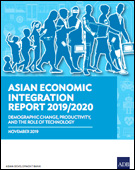 Asian Economic Integration Report 2019/2020: Demographic Change, Productivity, and the Role of TechnologyThis report reviews economic cooperation and integration in Asia and the Pacific. It reports that in 2018, the South Asia Subregional Economic Cooperation (SASEC) focused on reducing gaps in multimodal connectivity among its member countries. By the end of 2018, 52 ADB-financed projects worth $11.36 billion had been committed to SASEC projects, with an additional $106.44 million in 81 technical assistance grants. SASEC nodal officials and working groups met in Singapore in March 2018 to update the SASEC operational plan. The operational plan identified 77 projects ($45.6 billion) to be financed by SASEC members, ADB, and development partners. A holistic approach under the operational plan will build transport links with Southeast Asia and East Asia and expand regional trade markets. Author: Asian Development Bank Year: 2019 Download Tags: ADB, Regional Cooperation, SASEC, Trade Facilitation, Transport, Bangladesh, Bhutan, India, Maldives, Myanmar, Nepal, Sri Lanka Maritime Cooperation in SASEC: South Asia Subregional Economic CooperationMost South Asia Subregional Economic Cooperation (SASEC) countries rely on maritime transport for international trade. Stronger maritime relations are crucial to achieve the economic growth potential for the subregion. This report looks at how countries can strengthen international trade by improving maritime cooperation among the SASEC countries, comprised of Bangladesh, Bhutan, India, Maldives, Myanmar, Nepal, and Sri Lanka. It gives an overview of the SASEC maritime sector and identifies collaboration initiatives that could address key challenges. Author: Asian Development Bank Year: 2019 Download Tags: Transport, Trade Facilitation, Bangladesh, Bhutan, India, Maldives, Myanmar, Nepal, Sri Lanka, ADB RCI Asian Development Outlook (ADO) 2019 Update: Fostering Growth and Inclusion in Asia's CitiesGrowth in developing Asia remains strong despite the slowing down of international trade and a weakening of investments. In South Asia, growth momentum has slowed, with growth forecasts lowered to 6.2% for 2019 and retained at 6.7% for 2020. Growth in India has softened but is expected to bounce back to 7.2% in 2020. Bangladesh and Nepal performed better than projected. Bhutan’s growth slowed to 5.3% in fiscal year (FY) 2019 due to a decline in hydroelectric generation. Growth projection for FY2020 is retained at 6.0%. In Sri Lanka, growth forecast has been lowered for 2019 and 2020. Forecasts for Maldives is retained as tourist arrivals increased in the first half of 2019. In Southeast Asia, growth projections for Myanmar has been retained. Author: Asian Development Bank Year: 2019 Download Tags: Hydropower, ADB, Bangladesh, Bhutan, India, Maldives, Myanmar, Nepal, Sri Lanka Basic Statistics 2019Basic Statistics presents select economic, environmental, and social indicators used to track progress toward the Sustainable Development Goals. It includes indicators for development indicators for 46 economies in the Asia and Pacific region, including those for the seven SASEC countries: Bangladesh, Bhutan, India, Maldives, Myanmar, Nepal, and Sri Lanka. Author: Asian Development Bank Year: 2019 Download Tags: Bangladesh, Bhutan, India, Maldives, Myanmar, Nepal, Sri Lanka, Trade, Sustainable Development Goals, Energy Economic and Social Survey of Asia and the Pacific 2019: Ambitions beyond GrowthThe Asia-Pacific region needs an estimated $1.5 trillion per year to end poverty and hunger, provide basic health care, quality education, enabling infrastructure, and clean energy for all, and for climate action and living in harmony with nature. Available public and private resources make these ambitions affordable for most countries in the region. However, development partnerships and regional cooperation are needed for all countries to achieve these “ambitions beyond growth.” Author: United Nations Economic and Social Commission for Asia and the Pacific Year: 2019 Download Tags: Sustainable Development Goals, Bangladesh, Bhutan, India, Nepal, Maldives, Myanmar, Sri Lanka, Trade, Energy Connecting Corridors beyond Borders: Enabling Seamless Connectivity in the BBIN Subregion Trade connectivity is expected to bring economic growth and prosperity and reduce poverty in Bangladesh, Bhutan, India, and Nepal (BBIN). It will strengthen the economies of landlocked Bhutan and Nepal and give BBIN countries greater access to global markets for exports and imports. The Motor Vehicles Agreement will promote containerization of multimodal cargo movement, which will help reduce trade costs. This study identifies eight trade corridors in the BBIN countries and provides details on existing infrastructure, time-cost-distance analysis, and projected sociopolitical impact. Author: CUTS International Year: 2019 Download Tags: BBIN, BBIN Motor Vehicles Agreement, Transport, Bangladesh, Bhutan, India, Nepal Impact Evaluation of Energy Interventions: A Review of the EvidenceImpact evaluations in the energy sector has so far focused on rural electrification and improved cookstoves. However, most investments have been in power generation and transmission. This energy sector impact evaluation report assesses what has been produced against what might be possible. It summarizes outcomes of 85 impact evaluations of energy interventions in developing countries, including Bangladesh, Bhutan, India, and Nepal. It looks at evidence gaps and proposes future directions for impact evaluations in the energy sector. Author: David A. Raitzer, Nina Blöndal, and Jasmin Sibal Year: 2019 Download Tags: Energy, Bangladesh, Bhutan, Nepal, India Impact Evaluation of Transport Interventions: A Review of the EvidenceDevelopment of transport is integral to the development of economic corridors, regional economic integration, and trade. This publication reviews the impact of 91 transport interventions in developing countries, including Bangladesh, Bhutan, India, and Nepal. It summarizes the project outcomes, identifies evidence gaps, and presents proposals for future directions. Author: David A. Raitzer, Nina Blöndal, and Jasmin Sibal Year: 2019 Download Tags: Bangladesh, Regional Connectivity, Bhutan, India, Nepal, Rail, Road, Transport Renewable Capacity Statistics 2019This report provides renewable energy statistics for 2009–2018. It includes figures on total renewable energy capacity installed and connected by energy source (hydropower, wind energy, solar energy, etc.). It gives figures for capacity per region and per country, including those for Bangladesh, Bhutan, India, Maldives, Myanmar, Nepal, and Sri Lanka. Author: International Renewable Energy Agency Year: 2019 Download Tags: Renewable Energy, Bangladesh, Bhutan, India, Maldives, Myanmar, Nepal Asian Development Outlook (ADO) 2019: Strengthening Disaster ResilienceDeveloping Asia is projected to grow at 5.7% in 2019 and 5.6% in 2020. South Asia is projected to bounce back in 2019 and 2020 from the previous year’s slowdown. India’s growth is expected to pick up to 7.2% in 2019 (from 7.0% in the previous year) on recovery in agriculture and strong domestic demand. Bangladesh is projected to grow by 8.0% in 2019. Bhutan is expecting modest growth while the outlook for Maldives is for growth to moderate. Nepal should expect stable growth in 2019 while Sri Lanka is projected to recover moderately. Inflation in South Asia is projected to rise to 4.7% in 2019. Growth should pick up in Myanmar in Southeast Asia. Author: Asian Development Bank Year: 2019 Download Tags: ADB, South Asia, Bangladesh, Bhutan, India, Myanmar, Maldives, Nepal, Sri Lanka Asian Development Outlook 2018 Supplement: The Outlook Firms as Trade Conflict PausesGrowth forecasts for developing Asia stand at 5.8% in 2019. South Asia is still the fastest-growing subregion in developing Asia, while 2019 forecasts are revised down marginally at 7.1%. Bangladesh maintains its growth momentum with the expansion of exports and remittances. Growth in Bhutan has moderated while tourist arrivals grew strongly in Maldives. India exports are increasing along with the country’s industrial and agricultural output. GDP in Sri Lanka grew by 3.7% amid revived private consumption. In Nepal, exports surged by 16.1% while remittances grew to a record $2.1 billion. Author: Asian Development Bank Year: 2018 Download Tags: ADB, Bangladesh, Bhutan, India, Maldives, Nepal, Sri Lanka South Asia Economic Focus, Fall 2018: Budget CrunchAmid a turbulent international environment, South Asia is expected to remain the fastest-growing region in the world. Growth in Bangladesh will be driven by consumption and public investment. In Bhutan, growth is expected to accelerate with the commissioning of two major hydropower projects. Growth in India firms up prompted by the adoption of the Goods and Services Tax and the recapitalization of banks. Maldives is projected to grow strongly based on dynamism in construction and tourism. Economic activity in Nepal is set to grow over the medium term while Sri Lanka’s economic growth will recover following 2017’s weather disruptions. The report highlights how growth performance is anchored on domestic consumption rather than private investment or exports. Author: World Bank Year: 2018 Download Tags: Bangladesh, Bhutan, Economic Growth, Exports Key Indicators for Asia and the Pacific 2018This report presents the latest economic, financial, social, and environmental statistics for the 48 regional members of the Asian Development Bank (ADB). In 2017, foreign direct investment flows to developing Asia was stable, with 8.8% going to South Asia; energy gains were made in five of six countries in South Asia; and starting a business continues become easier in most developing ADB member economies following lowered regulatory costs and simplified compliance procedures. Nepal and Armenia experienced the most rapid annual growth rate at 7.5%, while India witnessed a 6.7% growth in GDP. Author: Asian Development Bank Year: 2018 Download Tags: ADB, Energy, Transport, Bangladesh, Bhutan, India, Maldives, Nepal, Southeast Asia, Sri Lanka BBIN: Opportunities and ChallengesThe Bangladesh, Bhutan, India, and Nepal (BBIN) initiative focuses on establishing connectivity, which have helped foster regional trade and improve sustainable resource management. This publication contains discussions held at the Young Thinkers' Conference, entitled "BBIN: Opportunities and Challenges," held in 2017 in Kolkata, India. The section "Strengthening Connectivity in the BBIN" looks at how connectivity in the subregion could be increased through several measures that address a number of logistical handicaps. "BBIN: The Way Ahead" examines the need for cooperation among the countries to achieve collective growth. Author: Anasua Basu Ray Chaudhury et al Year: 2018 Download Tags: Bangladesh, BBIN, Bhutan, India, Nepal BIMSTEC and Japan: Exploring Prospects for Renewed CooperationThe Bay of Bengal region is rising as an economic and strategic hub, with the Bay of Bengal Initiative for Multi-Sectoral Technical and Economic Cooperation (BIMSTEC) playing a key role in promoting growth and development in the region. BIMSTEC is also being seen as a potential driver of integration between South Asia and Southeast Asia. Given Japan's relationship with BIMSTEC nations, this brief makes a case for deeper engagement between Japan and BIMSTEC. The benefits could include cooperation in infrastructure, connectivity, and energy projects. A free trade agreement between the two entities would also be mutually beneficial. Author: Vindu Mai Chotani Year: 2018 Download Tags: ASEAN, Bangladesh, Bhutan, BIMSTEC, Connectivity, India, Myanmar, Nepal, Sri Lanka, Free Trade Agreements Asian Development Outlook (ADO) 2018 Update: Maintaining Stability Amid Heightened UncertaintyThis Update forecasts 6.0% growth for the region in 2018 and 5.8% in 2019. In South Asia, economic outlook remains optimistic. The region is expected to sustain its growth momentum, and meet projections of 7.0% in 2018 and 7.2% in 2019. Forecast for India is maintained at 7.3% in 2018 and 7.6% in 2019. Robust investment climate in Bangladesh is driving projections from 7.0% to 7.9% in 2018 and 7.2% to 7.5% in 2019, and in Nepal, from 4.9% to 5.9% in 2018. A drop in domestic demand lowers growth projections for Bhutan, from 7.1% to 6.7% in 2018 and 7.4% to 7.1% in 2019, and Sri Lanka, from 4.2% to 3.8% in 2018 and 4.8% to 4.5% in 2019. Author: Asian Development Bank Year: 2018 Download Tags: South Asia, India, Bangladesh, Nepal, Sri Lanka, ADB, Bhutan Embracing the E-commerce Revolution in Asia and the PacificAsia is the world’s largest e-commerce marketplace. In South Asia, India has the largest e-commerce market at $33 billion in 2017. Maldives, Bhutan, and Sri Lanka lead the subregion in terms of percentage of the population with access to the internet. This report introduces a framework for analyzing the quality of e-commerce development in the Asia-Pacific region and discusses lessons learned regarding e-commerce development. The framework incorporates economic factors, institutional environment, and social acceptance to assess e-commerce development and suggest the way forward. Author: Asian Development Bank, United Nations Economic and Social Commission for Asia and the Pacific Year: 2018 Download Tags: ADB, ICT, Trade, UNESCAP, Maldives, Bhutan, Sri Lanka Asian Development Outlook 2018 Supplement: The Outlook Remains Stable South Asia continues to be the fastest expanding subregion, with growth on track to achieve forecasts of 7.0% in 2018 and 7.2% in 2019. India will meet April forecasts of 7.3% in 2018 and 7.6% in 2019. Owing to strong agricultural growth in Bangladesh and industry growth in Nepal, 2018 GDP growth in the two countries surpassed earlier forecasts. Decline in construction slowed Sri Lanka’s economic growth to 3.2% while hydropower production was lower than forecast in Bhutan. Cement, wood, and metal imports grew in Maldives. Author: Asian Development Bank Year: 2018 Download Tags: ADB, Bangladesh, Bhutan, Energy, Hydropower, India, Maldives, Nepal, Sri Lanka Basic Statistics 2018Basic Statistics presents development indicators for 45 economies in the Asia and Pacific region, including those for the seven SASEC countries, Bangladesh, Bhutan, India, Maldives, Myanmar, Nepal, and Sri Lanka. It presents selected core indicators such as international and national poverty rates, inflation, and current account balance. It also presents information on indicators related to land, population, sustainable development goals, national accounts, money, balance of payments, reserves, external debt, and central government finance. Author: Asian Development Bank Year: 2018 Download Tags: Energy, ADB, Trade, Sustainable Development Goals, Bangladesh, Bhutan, India, Maldives, Myanmar, Nepal, Sri Lanka Asian Development Outlook (ADO) 2018: How Technology Affects JobsDeveloping Asia is forecast to expand by 6.0% in 2018 and 5.9% in 2019. Growth in South Asia is expected to be revived after a two-year slowdown. India is expected to bounce back to 7.3% in 2018 and 7.6% in 2019 owing to the effects of tax and banking reforms and corporate deleveraging. Growth will be strong in the rest of South Asia, with a forecast of 7.0% in 2018 and 7.2% in 2019, but expansion will be affected in Bangladesh and Sri Lanka following a need to carry out revenue-enhancing fiscal reform and to strengthen economic policy. Inflation forecast in South Asia is 4.7% in 2018 and raised to 5.1% in 2019. Author: Asian Development Bank Year: 2018 Download Tags: ADB, Bangladesh, Bhutan, India, Employment, Jobs, Maldives, Myanmar, Nepal, Sri Lanka, Technology Renewable Capacity Statistics 2018This publication provides statistics on renewable power generation capacity for the last decade. It gives figures for global capacity, capacity per region, and capacity per country, including those for Bangladesh, Bhutan, India, Maldives, Myanmar, Nepal, and Sri Lanka. Figures include those for total energy generation capacity, total renewable capacity, and capacity by energy source (hydropower, wind energy, solar energy, etc.). Author: International Renewable Energy Agency Year: 2018 Download Tags: Hydropower, Renewable Energy, Bangladesh, Bhutan, India, Maldives, Myanmar, Nepal, Sri Lanka ADB Annual Report 2017The Asian Development Bank (ADB) 2017 Annual Report details ADB’s operations, activities, and financial results over the year. In South Asia, finance ministers from South Asia Subregional Economic Cooperation (SASEC) member countries launched the SASEC Vision, which sets a long-term strategy for inclusive growth for the region. ADB also signed seven SASEC projects worth a combined $1.33 billion, bringing SASEC’s cumulative investment portfolio to $10.72 billion. ADB helped form SASEC working groups for cross-border trade and supported economic corridors in Bangladesh, India, and Sri Lanka to facilitate trade and investment in South Asia. Author: Asian Development Bank Year: 2018 Download Tags: ADB, Bangladesh, Bhutan, India, Regional Cooperation, SASEC, South Asia Global Investment Competitiveness Report 2017/2018: Foreign Investor Perspectives and Policy ImplicationsThis report provides analytical insights and empirical evidence on foreign direct investment’s (FDI) drivers and contributions to economic transformation. Data are categorized by sector and geographic origin and destination of investment, including analysis for SASEC countries using data for Bangladesh, Bhutan, India, Myanmar, Nepal, and Sri Lanka. The report explores the potential of FDI to create growth for local firms, assesses the effectiveness of fiscal incentives in attracting FDI, and gives practical recommendations to developing countries. Author: World Bank Group Year: 2018 Download Tags: Bangladesh, Bhutan, FDI, India, Nepal, Sri Lanka, Trade, WB, Myanmar Harmonizing Electricity Laws in South AsiaMany in South Asia face electricity shortages that affect their socioeconomic development. But the region has a large hydropower potential and other energy resources that may be harnessed to drive growth in the region. This report looks at legal, regulatory, technical, and commercial requirements for energy trade to advance in the region, and gives recommendations for implementing the South Asian Association for Regional Cooperation Framework Agreement on Energy Trade. Author: Asian Development Bank and the South Asian Association for Regional Cooperation in Law Year: 2017 Download Tags: Bangladesh, Bhutan, Energy, Harmonisation, India, Industrialization, Maldives, Nepal, Regional Cooperation, South Asia, Sri Lanka, Trade, ADB RCI Digital Trade Facilitation in Asia and the Pacific: Studies in Trade, Investment and InnovationDigital trade facilitation is reducing trade costs for developing economies, allowing them to use trade as an engine of growth and sustainable development. This report provides an overview of trade facilitation and paperless trade implementation in the Asia-Pacific region. It analyzes the impact on trade costs of trade facilitation measures and reviews paperless trade provisions in recent regional trade agreements. Among the countries surveyed are Bangladesh, Bhutan, India, Maldives, Nepal, and Sri Lanka. Author: United Nations Economic and Social Commission for Asia and the Pacific Year: 2017 Download Tags: Bangladesh, Bhutan, India, Maldives, Nepal, Sri Lanka, Trade Facilitation Agreement, WTO Least Developed Countries Report 2017This report focuses on transformational energy access for the LDCs, where 62% of people have no access to electricity. It makes a case for trade in electricity, such as the 2014 South Asian Association for Regional Cooperation framework agreement for regional cooperation on electricity among Afghanistan, Bangladesh, Bhutan, India, Maldives, Nepal, Pakistan, and Sri Lanka. International and regional trade in electricity could help lower electricity prices, mitigate power shocks, relieve shortages, and facilitate the transition to cleaner energy. Author: United Nations Conference on Trade and Development Year: 2017 Download Tags: Bangladesh, Bhutan, Maldives, Nepal, Sri Lanka, Energy, Least Developed Countries, Trade SME Competitiveness Outlook 2017 – The Region: A Door to Global TradeThe most common form of trade for small and medium-sized enterprises (SMEs) is regional trade. This report shows that regional trade agreements deliver inclusive growth, attracting value chain activity and fostering competitiveness for small firms. It provides advice for policymakers, businesses, and trade and investment support institutions. The report also includes 50 country profiles—including those of Bangladesh, Bhutan, India, Nepal, and Sri Lanka—showing SME competitiveness and export potential by region. Author: International Trade Centre Year: 2017 Download Tags: Small and Medium Enterprise, Trade, Bangladesh, Bhutan, India, Nepal, Sri Lanka Key Indicators for Asia and the Pacific 2017This report gives the latest statistics on economic, financial, environmental, and Sustainable Development Goal (SDG) indicators for the 48 regional members of the Asian Development Bank, including up-to-date figures on energy, trade, and transport. In 2016, Asia and the Pacific accounted for 40.9% of global gross domestic product (GDP). While foreign direct investment (FDI) flows declined in East Asia and Southeast Asia in 2016, FDI flows to South Asia remained stable. The average number of days required to start a business in South Asia was 16. Energy consumption is also expected to increase in the coming decades owing to increasing GDP per capita and an increase in the use of energy-consuming goods. Author: Asian Development Bank Year: 2017 Download Tags: ADB, Energy, Transport, Bangladesh, Bhutan, India, Maldives, Nepal, Southeast Asia, Sri Lanka Asian Development Outlook (ADO) Supplement: A Firmer Growth Outlook for AsiaGrowth forecast for developing Asia for 2018 is downgraded to 5.8%, from projections in the Asian Development Outlook 2017 Update in September 2017. Forecasts for the region’s inflation rates have been retained at 2.9% for 2018. For South Asia, growth outlook for 2018 is retained at 7.0%. India’s gross domestic product (GDP) growth rebounded to 6.3% in FY2017 (ending 31 March 2018), led by manufacturing. Bangladesh showed higher GDP growth for FY2017 (ended 30 June 2017) than was previously estimated. Bhutan showed stronger growth than forecast, supported by transport and communication services and construction. Growth projections for Maldives, Nepal, and Sri Lanka are in line with those in the Update. Author: Asian Development Bank Year: 2017 Download Tags: ADB, India, Bangladesh, Bhutan, Maldives, Nepal, Sri Lanka, Manufacturing Asian Development Bank and Bhutan: Fact SheetThe Asian Development Bank (ADB) Fact Sheet provides social and economic indicators on Bhutan, as well as information on ADB operations and contact details. Since 1982, ADB has supported Bhutan through projects in energy, finance, and trade facilitation, and transport. ADB has approved loans totaling $498.81 million, grants of $222.4 million, and $73.48 million in technical assistance for Bhutan. ADB support reflects strong emphasis on green energy production, transport connectivity, and urban infrastructure projects. To make growth more inclusive, ADB will help Bhutan through projects focusing on cross-border connectivity, skills development, and agriculture. Author: Asian Development Bank Year: 2017 Download Tags: ADB, Bhutan, Energy, Connectivity, Transport, Agriculture, Roads 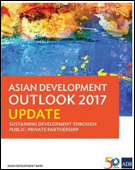 Asian Development Outlook (ADO) 2017 Update: Sustaining Development through Public-Private PartnershipDeveloping Asia is forecast to expand by 5.9% in 2017 and 5.8% in 2018, a slight upgrade from projections in the Asian Development Outlook 2017. However, growth forecast for South Asia is downgraded to 6.7% in 2017. India’s growth remains strong and most South Asian countries are expected to meet or exceed growth forecasts from April. Exceptions are Sri Lanka, where agriculture was affected by drought and floods, and Bhutan, where geological problems have constrained construction on two large hydropower projects. Growth in Nepal surged in 2017 on earthquake recovery but is slowing as agriculture struggles, following severe flooding in August 2017. Inflation forecast in South Asia is lowered to 4.2% for 2017 and 4.7% for 2018. Favorable global commodity prices, good harvests, and prudent macroeconomics are expected. Author: Asian Development Bank Year: 2017 Download Tags: Asia, Development, Sustainability, Public Private Partnerships, South Asia, India, Sri Lanka, Agriculture, Bhutan, Hydropower, Energy, Nepal 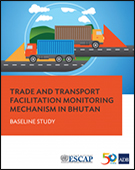 Trade and Transport Facilitation Monitoring Mechanism: Baseline Study in BhutanThis report synthesizes the business process analysis conducted on import of light motor vehicles from third countries to Bhutan via Kolkata Port, import of plastic kitchenware and tableware (melamine products) from Bangladesh to Bhutan, export of ferrosilicon from Bhutan to third countries through Kolkata Port, and export of cardamom from Bhutan to Bangladesh. It also measures the performance of trade corridors and border crossings in Bhutan, to quantify current trade and transport facilitation and provide recommendations. Findings of the study reveal bottlenecks to trade, including numerous procedures needed to complete import/export, and low speed along the trade corridors. The report includes specific short-term and long-term policies to improve Bhutan’s trade and transport facilitation. Author: Asian Development Bank and United Nations Economic and Social Commission for Asia and the Pacific Year: 2017 Download Tags: Bhutan, Trade Facilitation, Bangladesh, ADB, Transport, ADB RCI 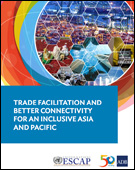 Trade Facilitation and Better Connectivity for an Inclusive Asia and PacificThis report investigates the evolution of trade costs, examines trade facilitation and paperless trade implementation, and highlights key initiatives in South Asia, including efforts by members of the South Asia Subregional Economic Cooperation (SASEC). The SASEC Trade Facilitation and Transport Working Group agreed to expand assistance to trade facilitation through technical assistance to support more efficient, transparent, secure, and service-oriented processing of cross-border trade across South Asia. Through 2025, the SASEC connectivity agenda will be better aligned with the frameworks of South Asian Association for Regional Cooperation and the Bengal Initiative for Multi-Sectoral Technical and Economic Cooperation. To help establish a trade and transport facilitation monitoring mechanism, Bangladesh, Bhutan, and Nepal conducted studies that reviewed trade and transport procedures, analyzed bottlenecks, and gave recommendations on trade and transport facilitation. Author: Asian Development Bank and United Nations Economic and Social Commission for Asia and the Pacific Year: 2017 Download Tags: ADB, Bangladesh, Bhutan, BIMSTEC, Maldives, Nepal, SAARC, India, Myanmar, SASEC, South Asia, Sri Lanka, Trade Facilitation, Transport, UNESCAP, ADB RCI 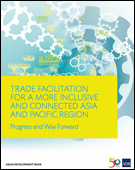 Trade Facilitation for a More Inclusive and Connected Asia and Pacific Region: Progress and Way ForwardThis report gives an overview of assessments from the 2017 global survey on trade facilitation and paperless trade in Asia and the Pacific. It looks at the implementation of trade facilitation and paperless trade measures in 44 countries in Asia and the Pacific, including how the South Asia Subregional Economic Cooperation Trade Facilitation Strategic Framework promotes development by deepening regional cooperation. The Framework covers national and subregional projects in Customs harmonization, improving cross-border facilities, and transport facilitation. The Framework also supports regulatory reforms and the development of the National Single Window Customs management system in Bangladesh, Bhutan, Maldives, and Nepal. Author: Asian Development Bank and United Nations Economic and Social Commission for Asia and the Pacific Year: 2017 Download Tags: ADB, Bangladesh, Bhutan, BIMSTEC, Maldives, Nepal, Regional Cooperation, Regional Integration, SAARC, SASEC, Standards Harmonization, Trade Facilitation, Trade Facilitation Agreement, WTO, UNESCAP, ADB RCI 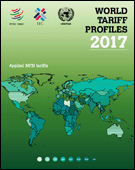 World Tariff Profiles 2017World Tariff Profiles is a joint publication of the World Trade Organization (WTO), International Trade Centre, and the United Nations Conference on Trade and Development devoted to information on market access for goods. It contains comprehensive data on tariffs and non-tariff measures imposed by over 170 countries and Customs territories. This year’s edition takes a close look at export diversification, analyzing to what extent economies have diversified their exports over time. Many countries make it a policy to diversify exports to obtain bigger market shares. An overview of export diversification shows how India, Myanmar, Sri Lanka, Bangladesh, and Bhutan have grown in the last two decades. Bangladesh in particular has achieved significant increase in terms of both product coverage and market reach. Author: World Trade Organization, International Trade Centre, and the United Nations Conference on Trade and Development Year: 2017 Download Tags: Bangladesh, Bhutan, Export, India, Maldives, Myanmar, Nepal, Sri Lanka, Tariffs, Trade, UNCTAD, WTO SARSO News: Vol. 31, No. 2The South Asian Regional Standards Organization (SARSO) newsletter features updates on SARSO events and activities. This issue features the publication of three South Asian Association for Regional Cooperation standards on food quality and safety, and the workshop on the importance of ISO 14001—which aims to help organizations improve environmental performance through the efficient use of resources and reduction of waste—and its impact on the environment and trade. It also has reports on Workshop on Conformity Standards held in New Delhi, India, and the Enhancing Capacity for Sanitary and Phytosanitary (SPS) Measures for Safe Trade in Animal and Animal Products in South Asia held in Kathmandu, Nepal. Author: South Asian Regional Standards Organization Year: 2017 Download Tags: Agriculture, Bangladesh, Bhutan, India, Nepal, SAARC, SARSO, South Asia, Standardization, Trade World Trade Statistical Review 2017The World Trade Statistical Review looks at the last 10 years and examines the latest developments in world trade, with a detailed analysis of the most recent trends for trade in goods and services. The book gives information on the participation of India, Bangladesh, and other South Asian economies in world trade, and highlights trends in the use of trade-facilitating measures. It also gives information on the implementation of the WTO Trade Facilitation Agreement and regional trade agreements, such as the South Asian Free Trade Arrangement. Author: World Trade Organization Year: 2017 Download Tags: Export, Least Developed Countries, Aid for Trade, SAFTA, South Asia, Trade Facilitation, WTO, Bangladesh, Bhutan, India, Maldives, Myanmar, Nepal, Sri Lanka Trade and Transport Facilitation Monitoring Mechanism: Baseline Study in BangladeshThis report synthesizes the business process analysis conducted on the export of plastic kitchenware and tableware from Bangladesh to Bhutan through Burimari land port, and the import of lentils from Nepal to Bangladesh through Banglabandha land port, as well as studies on trade corridors and border crossings in Bangladesh, to quantify current trade and transport facilitation in Bangladesh through a set of indicators. Findings of the study reveal bottlenecks to trade, including costly one-time procedures for a new trader, numerous documents and copies required to complete export and import processes, and low speed along the trade corridors. This report includes specific short-term and long-term policies to improve Bangladesh’s trade and transport facilitation. Author: Asian Development Bank Year: 2017 Download Tags: Trade Facilitation, Transport, Bhutan, Bangladesh, Nepal, SASEC, ADB RCI 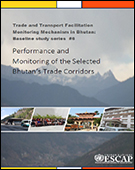 Performance and Monitoring of Selected Bhutan’s Trade CorridorsThis report on performance and monitoring of two corridors, the Kolkata-Phuentsholing corridor and the Burimari-Phuentsholing corridor is the sixth of a six-part study on Trade and Transport Facilitation Monitoring Mechanism (TTFMM) in Bhutan. The study finds that average speed along the corridor is very low. Along the Kolkata-Phuentsholing corridor, average speed with delays is 9 kilometers per hour (km/h) and without delays is 15 km/h. Along the Burimari-Phuentsholing corridor, average speed with delays is about 5 km/h and without delays is 16 km/h. The challenges to ensuring efficient transport along the corridor remain significant, yet the study sees tremendous opportunities for improvement, and raises the importance of continuous and effective monitoring to observe whether trade and transport performance along the corridor improve over time. Author: United Nations Economic and Social Commission for Asia and the Pacific Year: 2017 Download Tags: UNESCAP, Bhutan, Trade Facilitation, Transport Time Release Study in PhuentsholingThis Time Release Study report undertaken at Phuentsholing Land Border Crossing Station in Bhutan is the fifth of a six-part study on Trade and Transport Facilitation Monitoring Mechanism (TTFMM) in Bhutan. According to the study, the average time taken for clearance of import goods from India is 58 minutes for taxable goods and 28 minutes for non-taxable/exempted goods. Imports from third countries take around 16 hours for taxable goods and 7 hours for non-taxable/exempted goods. Export of goods to India and third countries follow the same procedure, with around 13 minutes on the average needed to clear export goods. Specific recommendations are given to further enhance the efficiency of clearance of goods at the borders, including conducting the TRS on a regular basis. Author: United Nations Economic and Social Commission for Asia and the Pacific Year: 2017 Download Tags: UNESCAP, Trade Facilitation, Bhutan Business Process Analysis of Export of Ferro Silicon from Bhutan to the Third CountriesThis business process analysis report on the export of Cardamom from Bhutan to Bangladesh via Phuentsholing-Jaigaon-Changrabandha-Burimari is the fourth of a six-part study on Trade and Transport Facilitation Monitoring Mechanism (TTFMM) in Bhutan. According to the study, it takes 29 days to complete all export procedures for new traders. The process is reduced to 26.5 days without the first time procedures. Total cost to export a typical truckload of two metric tons of cardamom is around $654, with one-time procedures amounting around $308. 24 documents are needed to complete the export process, with some documents requiring extra copies, numbering to as much as 71. Specific recommendations are given to improve trade in this commodity. Author: United Nations Economic and Social Commission for Asia and the Pacific Year: 2017 Download Tags: Bangladesh, Bhutan, Trade Facilitation, Transport Business Process Analysis of Import of Light Motor Vehicles from the Third Countries to Bhutan via Kolkata PortThis business process analysis report on the import of light motor vehicles (LMVs) from third countries to Bhutan via Kolkata Port is the first report of a series of a six-part study on Trade and Transport Facilitation Monitoring Mechanism (TTFMM) in Bhutan. Study findings reveal it takes 28.5 days to import LMVs from the Republic of Korea, with costs amounting to around $1,289 to complete the import procedures, not including the applicable duty and taxes payable in Bhutan. 39 documents are needed to complete the import process, with 12 documents requiring extra copies. Specific recommendations are given to improve trade in this commodity. Author: United Nations Economic and Social Commission for Asia and the Pacific Year: 2017 Download Tags: UNESCAP, Bhutan, Trade Facilitation, Transport Lessons from ADB Transport Projects: Moving Goods, Connecting People, and Disseminating KnowledgeThis publication shares 20 case stories from the Asian Development Bank bearing practical lessons for transport projects across Asia and the Pacific region under different socioeconomic and political situations. The book includes reports on improving aviation in Bhutan, working on computerized transport and trade logistics in Nepal, and constructing Sri Lanka's Greenfield Highway, and the role policy plays in those projects. It also draws lessons from how India's road development increased rural communities' access to public services and economic opportunities, and how participatory processes in selecting road improvement projects in Bangladesh provide a model for long-term plan for road maintenance. Author: Asian Development Bank Year: 2017 Download Tags: ADB, Bangladesh, Bhutan, India, Nepal, Railway, Sri Lanka, Transport, ADB RCI Regional Cooperation for Sustainable Energy in Asia and the PacificCountries in the Asia-Pacific region face multiple energy-related challenges, which are driving transformation of energy systems. Addressing these energy challenges is an integral part of implementing the 2030 Agenda for Sustainable Development, including ensuring access to affordable, reliable, sustainable, and modern energy for all. This report analyzes challenges in the Asia-Pacific region and its efforts to accelerate the energy transition to achieve Sustainable Development Goal 7. Author: United Nations Economic and Social Commission for Asia and the Pacific Year: 2017 Download Tags: Asia-Pacific, Energy, Sustainability, Sustainable Development Goals, UNESCAP, Bangladesh, Bhutan, India, Maldives, Myanmar, Nepal, Sri Lanka Eradicating Poverty and Promoting Prosperity in a Changing Asia-PacificThis report explores five long-term trends in the Asia-Pacific region that will shape approaches to poverty alleviation and the prospects for achieving prosperity: regional economic cooperation and integration; rural–urban transitions; demographic changes; ICT access and connectivity; and demand for natural resources. It examines the changing development context in South Asian and other economies. It also looks at opportunities created by regional cooperation and integration that intend to bring about shared economic benefits. Author: United Nations Economic and Social Commission for Asia and the Pacific, Asian Development Bank, United Nations Development Programme Year: 2017 Download Tags: ADB, Connectivity, ICT, Regional Cooperation, Sustainability, UNESCAP, UNDP, Bangladesh, Bhutan, India, Maldives, Nepal, Sri Lanka 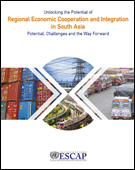 Unlocking the Potential of Regional Economic Cooperation and Integration in South AsiaAt a modest 6% of total trade, intraregional trade in South Asia stands at less than one third of its full potential. Trade barriers and inadequate infrastructure have cost South Asia over US $54 billion per year in lost export opportunities. With 309 million people living on less than $1.90 a day—the largest concentration of poverty in the world—South Asia should urgently pursue broad-based regional economic cooperation that could enable effective responses to the subregion’s developmental challenges. This report examines the state of economic integration in South Asia and identifies potential areas for further strengthening subregional linkages. It provides recommendations on policy actions to increase market integration, improve connectivity, boost investment in infrastructure development, and tackle shared vulnerabilities and risks. It calls for the consolidation and upgrading of existing trade and investment cooperation initiatives into a South Asia Comprehensive Economic Partnership. Author: United Nations Economic and Social Commission for Asia and the Pacific Year: 2017 Download Tags: BIMSTEC, Investment, Regional Cooperation, SAARC, South Asia, Sustainability, Sustainable Development, Trade, UNESCAP, Bangladesh, Bhutan, India, Maldives, Myanmar, Nepal, Sri Lanka 2016 Development Effectiveness ReviewThe Development Effectiveness Review tracks development progress in Asia and the Pacific and monitors the Asian Development Bank’s (ADB) effectiveness 2010-2016. For South Asia, ADB shares results in regional cooperation, energy, and road and rail transport. ADB also approved $4.4 billion in financing for projects in South Asia during 2016. The Review includes details of ongoing and newly approved projects. Author: Asian Development Bank Year: 2017 Download Tags: ADB, Asia-Pacific, Development, Poverty Reduction, Regional Cooperation, Regional Integration, Roads, Transport, Bangladesh, Bhutan, India, Maldives, Nepal, Sri Lanka The Little Data Book on Information and Communication TechnologyThis book presents quick indicators for more than 200 countries showing data on key indicators of information and communications technology (ICT), including access, quality, affordability, efficiency, sustainability, and applications. It includes data for Bangladesh, Bhutan, India, Maldives, Myanmar, Nepal, and Sri Lanka. Author: World Bank and International Telecommunications Union Year: 2017 Download Tags: Bangladesh, Bhutan, ICT, India, Maldives, Myanmar, Nepal, Sri Lanka, South Asia, WB 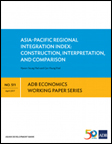 Asia-Pacific Regional Integration Index: Construction, Interpretation, and ComparisonDeeper regional integration expands markets, helps maximize the efficiency of resource allocation, and boosts productivity and investment opportunities, all serving stronger economies. This study proposes a regional integration index for Asia and the Pacific, the Asia-Pacific Regional Integration Index (APRII), comprising 26 indicators that measure various aspects of regional integration along six dimensions: trade and investment integration, money and finance integration, regional value chains, infrastructure and connectivity, free movement of people, and institutional and social integration. In the overall APRII, India ranks 14th—scoring closely to the Asia region integration average of 0.473—and scores highest on regional value chains and institutional and social integration. Nepal ranks 15th, scoring highest on regional value chains and trade and investment integration. Bangladesh and Sri Lanka rank 18th and 20th, respectively, and score highest on regional value chains. Maldives ranks 21st, scoring highest on free movement of people. Myanmar and Bhutan ranks 26th and 27th, and both score highest on trade and investment integration. In the overall regional integration indexes of selected Asian subregions, South Asia ranks 4th. Author: Hyeon-seung Huh, Cyn-Young Park Year: 2017 Download Tags: Regional Integration, Nepal, Bangladesh, Maldives, Myanmar, Bhutan Basic Statistics 2017Basic Statistics 2017 contains development indicators for 45 economies in the Asia and Pacific Region, including the seven SASEC countries, Bangladesh, Bhutan, India, Maldives, Myanmar, Nepal, and Sri Lanka. It includes selected indicators of the Sustainable Development Goals (SDGs) such as the proportion of population living below $1.90 (PPP) a day, proportion of population with access to electricity, renewable energy share in the total final energy consumption, unemployment rate, total official flows for infrastructure, and trade balance. Author: Asian Development Bank Year: 2017 Download Tags: Energy, Trade Facilitation, Transport, Sustainable Development Goals, Bangladesh, Bhutan, India, Maldives, Myanmar, Nepal, Sri Lanka Asian Development Outlook 2017: Transcending the Middle-Income Challenge The Asian Development Outlook 2017 forecasts 5.7% growth for developing Asia in 2017 and 2018, and 7% and 7.2% for South Asia in 2017 and 2018. Resumption of growth in South Asia follows the brief slowdown in 2016 due to decline in fixed investment and impact of demonitization on trade and commerce. Growth in India is forecast at 7.4% in fiscal 2017 and 7.6% in 2018. In Bhutan, growth is expected to accelerate to 8.2% in 2017, with expanded investment in hydropower for export, and added capacity in electricity generation. Nepal's growth is expected to revive to 5.6% in 2017 with increased post-earthquake reconstruction and more reliable electricity. Author: Asian Development Bank Year: 2017 Download Tags: ADB, India, Bhutan, Nepal, South Asia Facilitate Trade for Development: Aid for Trade The Aid for Trade program has been providing support to developing economies in tackling obstacles to growth through better facilitation of trade in the last 10 years. Since its launch in 2006, a total of $308 billion has been disbursed to finance aid-for-trade programs and projects, which are working to reduce trade and transport costs, promote trade expansion, and achieve economic and social objectives. As high trade costs persist in keeping developing countries from fully exploiting their trade and development potential, the Aid for Trade program remains highly relevant, and will help developing economies, including landlocked and small and vulnerable economies, achieve the 2030 Agenda for Sustainable Development. Author: William Hynes and Frans Lammersen Year: 2017 Download Tags: Trade, Development, Aid for Trade, Trade Facilitation, Transport, Bangladesh, Bhutan, Myanmar, Nepal, Least Developed Countries 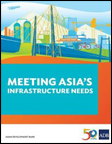 Meeting Asia's Infrastructure NeedsThis report estimates infrastructure investment needs in Asia and the Pacific for 2016-2030, updating the Asian Development Bank's assessment for 2010-2020 published in 2009. The report places developing Asia's investment needs at $26 trillion to maintain its growth momentum, eradicate poverty, and respond to climate change. While developing Asia's infrastructure, including its transport network and electricity generation capacity, has improved significantly over the years, it remains far from adequate – lack of reliable power supply continues to constrain economic growth and traffic congestion results in lost productivity, wasted fuel, and human stress. The report recommends $14.7 trillion investment for power and $8.4 trillion for transport. South Asia requires investments valued at 8.8% of gross domestic product. Author: Asian Development Bank Year: 2017 Download Tags: Asia, South Asia, Energy, Transport, Bangladesh, Bhutan, ADB, India, Maldives, Myanmar, Sri Lanka, Nepal 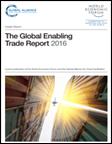 Global Enabling Trade Report 2016The Global Enabling Trade Report has been created to provide insight into trade policy and practice. It includes the Enabling Trade Index (ETI), which assesses the extent to which economies have in place institutions, policies, infrastructures and services facilitating the free flow of goods over borders and to their destination. This edition highlights that while an increasingly globalized trading system has been lifting millions out of poverty, trade barriers and costs are still preventing millions of people around the world from engaging in international trade. It reports that all South Asian economies have improved their ETI score over the past two years, with Bhutan as the most improved country in the region, jumping 12 places to 92, followed by India at 102, Sri Lanka at 103, Nepal at 108, Pakistan at 122, and Bangladesh at 123, yet the region remains the most closed worldwide. While South Asia has improved its access to foreign markets and adoption of ICTs, it needs to improve access to its domestic market – on average, South Asian countries impose a tariff of 16.7% on imported products – and enhance its transport infrastructure, particularly in Bhutan and Nepal. Author: Global Alliance for Trade Facilitation and the World Economic Forum Year: 2016 Download Tags: Trade, Trade Facilitation, Transport, Trade Policy, World Economic Forum, Bangladesh, Bhutan, India, Sri Lanka, Pakistan 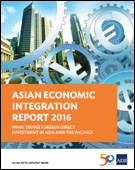 Asian Economic Integration Report 2016: What Drives Foreign Direct Investment in Asia and the Pacific?The 2016 Asian Economic Integration Report reviews regional economic cooperation and integration in Asia and the Pacific, amidst the rising global uncertainty following the United Kingdom’s referendum on leaving the European Union and the U.S. election, slower-than-expected global economic recovery, and ongoing economic restructuring in the People’s Republic of China and growth moderation. Asia faces heightened uncertainty–trade growth decelerated in 2015, falling to 2.3% in 2015; subregional trade linkages continue to strengthen, but inter-subregional trade linkages weakened; and non-tariff measures have become major obstacles to trade. In South Asia, SASEC cooperation has improved access to key markets in smaller economies, reduced real trade costs and behind-the-border barriers to stimulate investment; and enabled cross-border power exchanges to ensure power supply affordability, reliability, and overall grid stability. However, the SASEC agenda needs to be framed within wider integration processes taking place in Asia in the next decade to enhance economic linkages, and harness the full potential of Asian integration. Author: Asian Development Bank Year: 2016 Download Tags: ADB, ASEAN, Asia-Pacific, Development, FDI, Free Trade Agreements, Regional Cooperation, Regional Integration, SASEC, Trade Facilitation, UNCTAD, Bangladesh, Bhutan, India, Maldives, Nepal, Sri Lanka 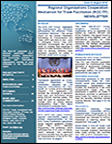 Regional Organizations Cooperation Mechanism for Trade Facilitation (ROC-TF) Newsletter: Issue X, August 2016This issue highlights the framework agreement on cross-border paperless trade facilitation adopted by the United Nations Regional Commission for Asia-Pacific, which will facilitate the exchange of electronic trade data and documents between participating United Nations Economic and Social Commission for Asia and the Pacific (UNESCAP) member states, and the 2016 Global Facilitation Partnership for Transportation and Trade forum. The latterencourages the private sector to mobilize expertise in support of trade facilitation reforms to develop effective trade facilitation solutions for small and medium-sized enterprises. The Newsletter also features SASEC-supported initiatives, including the launch of the new Maldives Customs Service training module on Customs valuation, as well as data collection for establishing the Trade and Transport Facilitation Monitoring baseline in Bhutan. The ROC-TF newsletter is a biannual publication featuring updates, publications and forthcoming activities of regional and international organizations working on trade facilitation in the Asia-Pacific region, including the Asian Development Bank, the World Customs Organization, and UNESCAP. Author: United Nations Economic and Social Commission for Asia and the Pacific Year: 2016 Download Tags: Trade Facilitation, ICT, Maldives, Customs, SASEC, Customs Valuation, Bhutan 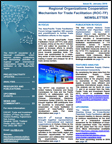 Regional Organizations Cooperation Mechanism for Trade Facilitation, Issue IX, January 2016This biannual publication features updates, publications and forthcoming activities of regional and international organizations working on trade facilitation in the Asia-Pacific region, including the Asian Development Bank (ADB), the World Customs Organization (WCO), and the United Nations Economic and Social Commission for Asia and the Pacific. It includes highlights of the Asia Pacific Trade Facilitation Forum 2015 and the Train-the-Trainer Workshops on Customs Valuation through Post Clearance Audit being jointly implemented by the WCO and ADB in the 6 SASEC member countries. This issue also features an analysis on achieving seamless supply chains through implementing comprehensive and pragmatic national trade facilitation reform programs. Author: UNESCAP Year: 2016 Download Tags: Trade Facilitation, Asia-Pacific, WCO, ADB, UNESCAP, Customs Valuation, Nepal, Bangladesh, Bhutan, India, Maldives, Sri Lanka Disentangling Transit Costs and Time in South AsiaLandlocked least developed countries are often hugely disadvantaged from a lack of effective transit options, which raise transportation costs and decrease their effective participation in international trade. This study examines trade barriers that impede the trade flow of Bhutan and Nepal through India's gateway ports of Haldia and Kolkata, under the overarching research theme of the impact of regional infrastructure for trade facilitation on growth and poverty reduction. It analyzes the impact of transit regulations and agreements on the cost of services required to transit goods between the ports and Bhutan or Nepal, to identify how the two landlocked countries are affected by the cost of transit services, which trade costs vary most significantly, and how firms are affected by the cost of transit services. Author: Prabir De, editor Year: 2015 Download Tags: Trade Facilitation, Transport Facilitation, Bhutan, Nepal Asian Development Outlook 2015 Supplement: Growth Holds Its Own in Developing AsiaThis Supplement maintains growth forecast for developing Asia at 5.8% in 2015 and 6.0% in 2016. In South Asia, economic outlook remains optimistic, with the region on track to meet Update projections of 6.9% in 2015 and 7.3% in 2016. India's economic expansion balances a slowdown in Bhutan—owing to weaker sales of hydropower—and the Maldives in 2015, and in Nepal in 2016—due to unfavorable weather and unforeseen delays in earthquake-related reconstruction. Growth projections for Bangladesh and Sri Lanka remain in line with those in the Asian Development Outlook Update. Author: Asian Development Bank Year: 2015 Download Tags: ADB, South Asia, Bangladesh, Bhutan, India, Maldives, Nepal, Sri Lanka 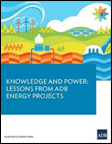 Knowledge and Power: Lessons from ADB Energy ProjectsThis publication highlights good practices and lessons learned from Asian Development Bank projects in energy, which comprised 26.5% of ADB's total lending commitments from 2008 to 2014. It discusses how the region's energy sources are utilized, providing updates on recent developments and challenges, highlighting the need for sustainable energy initiatives. Featured projects include the Green Power Development Project in Bhutan, which developed clean energy for regional use and promoted cross-border power trade. As the first infrastructure-focused public-private partnership in Bhutan, it also illustrated how projects can benefit with the active participation of the private sector, foreign parties, and commercial and public financial institutions. Also featured is the Bangladesh-India Electrical Grid Interconnection Project, which reduced Bangladesh's energy deficiency by enabling the country to affordably import 500 megawatts of electricity from India. This electrical link laid the groundwork for a regional energy market, an important step toward achieving a functioning regional electricity network in South Asia. Author: Asian Development Bank Year: 2015 Download Tags: Energy, Bangladesh, Bhutan, India, Regional Cooperation Doing Business 2016The World Bank's Doing Business 2016: Measuring Regulatory Quality and Efficiency reports that South Asia ranked second among regions, after Europe and Central Asia, in the largest share of economies implementing at least one reform to make doing business easier in the past year. 6 out of 8 economies in South Asia implemented a total of 9 reforms, including Bhutan, India - following the Government of India's ambitious program to increase ease of doing business launched in 2014 - and Sri Lanka. However, South Asia still lags behind in use of online systems in regulatory processes. The highest ranked economy in the region is Bhutan, with a global ranking of 71. Author: The World Bank Year: 2015 Download Tags: Business Efficiency, ICT, Bhutan, WB A Framework of Trade Policy for Bhutan: Compatible with the Gross National HappinessThis paper examines the compatibility between Bhutan's gross national happiness (GNH) index and trade policy, and attempts to contextualize Bhutan's trade policy issues - inclusive growth, trade facilitation, incidence of tariffs, and World Trade Organization accession. It explores trade and industry policy that is compatible with GNH guidelines, which aim to measure and improve people's holistic well-being: although it also includes factors that are seemingly unfavorable to an active trade policy. The report recommends benchmarking successful development strategies in other countries and creating an organization to pursue a more active trade policy to accomplish the urgent task of raising general living standards. Author: Inkyo Cheong, Taeho Bark, and Hoe Yun Jeong Year: 2015 Download Tags: Bhutan, WTO, Trade Policy, ADB 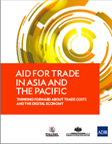 Aid for Trade in Asia and the Pacific: Thinking Forward About Trade Costs and the Digital EconomyAid for Trade (AfT) flows have increased each year since 2006 in Asia and the Pacific. While regional aggregate trade costs continue to fall, many subregions still struggle with trade costs that are substantially higher than the global average. This report highlights and explores how AfT contributed to these emerging trends in Asia and the Pacific and how to continue to address trade costs moving forward. Among the subregions, the Pacific (along with South Asia) has made the greatest improvements in the Logistics Performance Index from 2007-2014. Recent exporter surveys reveal a movement toward niche products and leveraging of e-commerce as a means to overcome cost and distance. Emerging digital technologies such as e-commerce further offers a new set of opportunities for economies in the region to grow through trade. Author: Asian Development Bank Year: 2015 Download Tags: Aid for Trade, Asia-Pacific, ICT, South Asia, Trade, Bangladesh, Bhutan, India, Sri Lanka, Agriculture, Energy, Transport Cross-Border Electricity Cooperation in South AsiaStrengthening cross-border electricity cooperation in South Asia can be part of the solution for providing adequate and reliable electricity. This World Bank Policy Research Working Paper reviews the status of cross-border electricity cooperation in South Asia, identifies key regional-level barriers to expand cross-border cooperation and trade in South Asia, and discusses the extent to which current domestic sector policies impede greater cross-border electricity cooperation. Finally, the findings offer policy recommendations on increased cross-border trade and cooperation. Author: Anoop Singh, Tooraj Jamasb, Rabindra Nepal, and Michael Toman Year: 2015 Download Tags: Energy, Regional Cooperation, Regional Trade, Bangladesh, Bhutan, India, Maldives, Nepal, South Asia, Sri Lanka, Trade, Trade Policy, WB 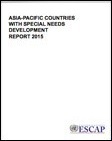 Asia-Pacific Countries with Special Needs Development Report 2015In the Asia-Pacific region, 36 out of the 58 economies are considered countries with special needs (CSN), which include least developed countries (LDC), landlocked developing countries, and small island developing States. This report highlights important areas that should be addressed as key priorities by CSNs such as economic diversification, external trade, South-South cooperation, and official development assistance including foreign direct investment. Bhutan and Nepal met the criteria for graduation from LDC status as of 2013. Other countries such as Bangladesh have a good chance of meeting the graduation criteria by 2018. Among the Small island developing States, Maldives is considered a success story in broadband internet connectivity. The results of this research show that Asia-Pacific CSNs must choose their paths to diversification carefully, depending on country circumstances. Author: United Nations Economic and Social Commission for Asia and the Pacific Year: 2015 Download Tags: Asia-Pacific, Least Developed Countries, Small Island Developing States, Bangladesh, Bhutan, Energy, FDI, Investment, Maldives, Nepal, Trade, Transport, UNESCAP 2015 Annual Evaluation ReviewCountry assessments conducted by an independent evaluation team between CY2010-CY2014, and published in the the Asian Development Bank’s (ADB) 2015 Annual Evaluation Review, show relatively good performance of ADB operations in South Asia. Programs implemented in Bhutan and India, notably, reflected more developed institutional and organizational capacities in ADB sectors of engagement, alongside robust private sector involvement. Nepal and Sri Lanka programs, though affected by civil strife, were also rated successful. This report examines ADB operational performance in 2014, and includes evaluation recommendations. It aims to enhance ADB effectiveness by providing feedback on policies, strategies, operations, and special concerns in Asia and the Pacific. Author: Independent Evaluation Department Year: 2015 Download Tags: ADB, Evaluations, India, Bhutan Electricity Consumption, Output, and Trade in BhutanThis ADB South Asia Working Paper examines the relationship between electricity consumption, international trade, and economic growth using an augmented production function framework. The findings show that Bhutan is energy-dependent and can promote economic growth through future investment in hydropower. More specifically, the results show that a 1% increase in (i) electricity consumption generates 0.03%-0.05% increase in output, (ii) total trade results in 0.5% increase in output, (iii) trade openness results in 1% increase in output. Author: Hooi Hooi Lean and Russell Smyth Year: 2015 Download Tags: Energy, Trade, Bhutan, ADB, South Asia, Hydropower, ADB RCI 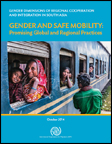 Gender Dimensions of Regional Cooperation in South Asia: Gender and Safe Mobility – Promising Global and Regional PracticesThis technical report analyzes global practices related to gender equality and safe migration, and their applicability to the context of South Asia. "Hard" aspects, such as physical infrastructure and equipment including border infrastructure, passenger holding facilities and surveillance cameras, and "soft" aspects, such as regional, bilateral and/or country-specific policies, programs, mechanisms and institutional linkages of safe mobility, are presented. The report also presents national policies and procedures that promote safe mobility. Given the lessons drawn from the reviewed policies and practices, it highlights the need for stronger evidence-based approaches in understanding the complex experience of women migrant workers, and identifies the need for more regular peer exchange through periodic regional dialogues of key stakeholder groups. Author: International Organization for Migration Year: 2014 Download Tags: Gender, Migration, South Asia, Bangladesh, Bhutan, India, Nepal, Transport, Trade 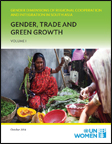 Gender Dimensions of Regional Cooperation in South Asia: Gender, Trade and Green Growth (Volumes I and II)This technical report presents an analysis of the interconnection between gender equality, regional trade and sustainable development in selected areas of four South Asian countries. In general, the report found women's contributions to total exports of all countries to be low, and in green exports to be lower. It identifies constraints and challenges, such as limited training in entrepreneurship, gender stereotypes related to green trade, existing gaps in policy framework, and weak access to technology, hindering women's participation in three green trade industries - agriculture and agro-processing, renewable energy, and ecotourism. The report looks at possible entry points for women, and recommended a list of actions to tap these identified entry points, including the need for greater exchange and cross-fertilization of experience among associations of women entrepreneurs and women’s chambers of commerce in South Asia. Author: Shreyasi Jha, Ritu Dewan, Amee Misra, Saloni Singh, Navanita Sinha, Maheen Sultan and Sonam Tobgay Year: 2014 Download Tags: Gender, Trade, Sustainability, South Asia, Bangladesh, Bhutan, India, Nepal SME Competitiveness and Aid for Trade: Connecting Developing Country SMEs to Global Value ChainsThis joint ITC-WTO study discusses constraints faced by small and medium-sized enterprises (SMEs) in international trade, particularly by least developed countries. It reviews how Aid for Trade addresses these challenges through a sample of 23 Diagnostic Trade Integration Studies. Three bottlenecks emerge – quality of business environment, access to finance, and lack of institutional support to overcome trade-related challenges. This study also highlights actions taken by companies to integrate SMEs into their supply chains and concludes with an analysis of recent private sector program evaluations. Author: International Trade Centre and World Trade Organization Year: 2014 Download Tags: SME, Trade, Private Sector, Small and Medium Enterprises, Bhutan, India, Nepal, Sri Lanka, Sustainability National Trade Facilitation Bodies in the World This UNCTAD publication provides the first, in-depth quantitative analysis of 50 existing national trade facilitation bodies and a first-hand set of recommendations from experiences of participating stakeholders. It offers policy-oriented conclusions to assist countries about to set up or strengthen their national trade facilitation working groups. The study reveals that the biggest challenge for trade facilitation working groups is sustainability. Its determining elements include the administrative culture of each country, level of development, or type of body and geographical region. Author: United Nations Conference on Trade and Development Year: 2014 Download Tags: Trade Facilitation, Trade Policy, Sustainability, UNCTAD, Bangladesh, Bhutan, Nepal, Sri Lanka 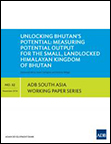 Unlocking Bhutan’s Potential: Measuring Potential Output for the Small, Landlocked Himalayan Kingdom of Bhutan The hydropower sector has driven Bhutan's economic growth in the past two decades with growth rates averaging 7.9%. Yet, the economy has not been invulnerable to market fluctuations and external shocks. This ADB South Asia Working Paper analyzes how Bhutan can create sustainable and inclusive growth, alongside the continuous expansion of its hydropower industry. It examines how certain policies can impact Bhutan's potential growth over 2013–2030. Results show that higher investment in education, health, and efforts to diversify its economic base—including enhancement of new industries with linkages to regional and global value chains—can further drive economic growth and improve the country's living standards. Author: Sabyasachi Mitra, Sarah Carrington, and Anthony Baluga Year: 2014 Download Tags: Bhutan, Energy, Economics, Hydropower, ADB, South Asia, Sustainability, Global Value Chains, Economic Growth A World Trade Organization for the 21st Century: The Asian PerspectiveThis Asian Development Bank Institute book examines key changes in the world trading system and explores policy implications for Asia. Through a compilation of essays from prominent international and Asian trade experts, this book presents interaction of market forces and trade regulation. Lessons from the Asian experience offer new approaches and economic policies to sustain growth, presenting the World Trade Organization as a forum to improve regional and global trade governance in the 21st century. Author: Richard E. Baldwin, Masahiro Kawai, Ganeshan Wignaraja (Eds.) Year: 2014 Download Tags: Trade, Trade Policy, WTO, Bangladesh, Bhutan, Energy, India, Maldives, Nepal, Sri Lanka, Transport Regional Transit Agreement in South Asia: An Empirical InvestigationThis discussion paper published by the South Asia Watch on Trade, Economics and Environment assesses the potential gains of a sub-regional transit arrangement and the removal of other border-trade barriers, particularly the eastern South Asia sub-region (Bangladesh, Bhutan, India and Nepal). It also discusses the link between transit and trade flows, provides profiles of intra-regional transit trade and current transit arrangements in South Asia, and identifies efficient regional transit corridors using linear programming or the Data Envelopment Analysis model. Author: Prabir De and Arvind Kumar Year: 2014 Download Tags: South Asia, Trade, Transport, Economics, Economic Corridor, SASEC, SAARC, UNESCAP, Customs, Harmonisation, Bangladesh, Bhutan, India, Nepal, Maldives, Sri Lanka Statistical Yearbook for Asia and the Pacific 2014The Statistical Yearbook contains comparative statistics and facts about the 58 regional members and associate members of the Economic and Social Commission for Asia and the Pacific. It includes brief analyses of 32 key development features such as energy supply and use, international trade, and transport, among others. In energy, the region’s production structure is highly resource-intensive, although per capita energy use is low. The section on international trade recommends focusing on raising domestic value-added rather than increasing gross exports in Asia and the Pacific. Finally, investment in environmentally sustainable transport is encouraged. Author: United Nations Economic and Social Commission for Asia and the Pacific Year: 2014 Download Tags: Asia-Pacific, Energy, Trade, Transport, Bangladesh, Bhutan, India, Maldives, Nepal, Sri Lanka NTMs in South Asia: Assessment and AnalysisThe study “NTMs in South Asia: Assessment and Analysis” analyzes how Non-tariff Measures (NTMs) give rise to non-tariff barriers, which are becoming increasingly crucial for advancing trade cooperation among member countries of the South Asian Association for Regional Cooperation, yet remain less-addressed. The study examines export potential and actual export of South Asian countries, and attempts to highlight gains from reduction in transaction costs in bilateral trade. It also notes that initiatives for trade facilitation reforms in South Asia at the regional level remain low in incentives and have yet to produce significant results. The study closes with several recommendations for reducing and eliminating NTMs. Author: Selim Raihan, Mostafa Abid Khan, and Shaquib Quoreshi Year: 2014 Download Tags: Trade Facilitation, Trade, SAARC, Bangladesh, Bhutan, India, Maldives, Nepal, South Asia, Sri Lanka 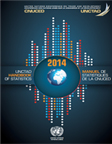 UNCTAD Handbook of Statistics 2014The UNCTAD Handbook of Statistics is a collection of statistics and indicators relevant to the analysis of international trade, investment and development. The 2014 edition shows the increasing convergence of trade balance between developing and developed economies continues. The report also includes regional trade data from South Asia that shows average annual growth rate of international trade improved from a previous deficit of -7.1% in 2012 to -0.1% in 2013. However, trade balance ran a deficit of -26.51% compared to the previous year's -25.94%. Trade indicators also report intra-trade in South Asian Association for Regional Cooperation region rose modestly from US$ 20,219 million to US$ 23,181 million between 2012 to 2013 and maintains intra-regional trade percentage at 5.8%. Author: United Nations Conference on Trade and Development Year: 2014 Download Tags: UNCTAD, Regional Trade, Development, Bangladesh, Bhutan, India, Maldives, Nepal, Sri Lanka, Transport 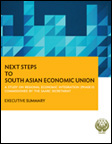 Next Steps to South Asian Economic UnionThis executive summary focuses on Phase II of the study on Regional Economic Integration, commissioned by the South Asian Association for Regional Cooperation (SAARC) Secretariat with the technical and financial assistance of the Asian Development Bank, and outlines a roadmap toward a South Asian Economic Union (SAEU). It presents an overview of intra-regional trade in South Asia—with India accounting for 65% of the region's combined total exports, and Sri Lanka 24% of total intra-regional imports—and discusses specific priority steps, using a phased and planned approach that quantifies potential gains from priority sectors identified in Phase I, needed to achieve regional economic integration. Thus, while non-tariff barriers, infrastructure constraints and other factors continue to challenge regional cooperation and integration in South Asia, reference by SAARC leaders toward an SAEU indicates a willingness to consider bold action. Author: Asian Development Bank Year: 2014 Download Tags: SAARC, South Asian Economic Union, Economic Integration, Bangladesh, Bhutan, India, Maldives, Nepal, Sri Lanka, Regional Integration Asian Economic Integration Monitor: November 2014This AEIM review of recent economic performance highlights the need for Asia to rebalance its sources of growth toward domestic and regional demand. It also shows a resilient Asia with rising GDP growth in South Asia. This issue includes a Special Chapter: Regional Financial Integration and Crisis in Asia and Europe – A Comparative Analysis. It presents Asia’s future path of integration as different from that in Europe. Asia will continue to strengthen efforts to harmonize rules and regulations in the financial sector and further unilateral trade and investment, while Europe is more likely to strengthen regional institutions to ensure recovery and better the monetary union. Author: Asian Development Bank Year: 2014 Download Tags: Asia-Pacific, Economic Integration, Europe, ASEAN, Bangladesh, Bhutan, India, Maldives, Nepal, Regional Integration, Sri Lanka, Trade Facilitation, Transport SASEC Website BrochureThis promotional brochure for the SASEC website features the web portal as a one-stop shop for information on SASEC activities, events, projects, and knowledge materials. The SASEC website seeks to build a dynamic discussion platform and repository of data on regional cooperation. Author: Asian Development Bank Year: 2014 Download Tags: SASEC, Knowledge Product, ICT, ADB, Bangladesh, Bhutan, India, Maldives, Nepal, South Asia, Transport, Trade Facilitation, Energy SASEC BrochureThis promotional brochure is a concise introduction to the South Asia Subregional Economic Cooperation (SASEC) Program, highlighting the main areas of regional cooperation and activity. It includes facts and figures about SASEC projects in transport, trade facilitation, energy, and ICT. Author: Asian Development Bank Year: 2014 Download Tags: SASEC, Trade Facilitation, Regional Cooperation, ICT, ADB, Bangladesh, Bhutan, India, Nepal, Maldives, Sri Lanka, Energy, Transport, Connectivity, Myanmar 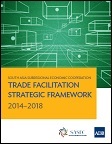 SASEC Trade Facilitation Strategic Framework 2014-2018The South Asia Subregional Economic Cooperation (SASEC) Trade Facilitation Strategic Framework 2014-2018 builds on the momentum of member countries over recent years in forging ahead with many significant improvements to facilitate, and ultimately increase, trade in the subregion and with the rest of the world. It supports the mission of the SASEC Transport and Trade Facilitation Strategy “to promote the prosperity of the subregion by facilitating the efficient movement of trade across the borders”, and focuses on five priority areas: customs modernization and harmonization; standards and conformity assessment strengthening; cross-border facilities improvement; through-transport facilitation; and institution and capacity building. Author: Asian Development Bank Year: 2014 Download Tags: SASEC, Trade Facilitation, Regional Cooperation, Transport, Trade, Customs, Standards, Harmonisation, Regional Integration, ADB, Bangladesh, Bhutan, India, Maldives, Nepal, Sri Lanka, South Asia, ADB RCI World Trade Report 2014 – Trade and Development: Recent Trends and the Role of the WTOThis annual publication highlights the relationship between trade and development, including changes since the start of the millennium. It identifies four key trends that altered the way trade affects development outcomes – accelerated economic growth in developing countries, expansion of global value chains, increase in agricultural and natural resource prices, and global nature of macroeconomic shocks. This report also explores how these trends have reshaped the role of trade in facilitating development and how recent development gains allow developing countries to adapt and mitigate risks. Author: World Trade Organization Year: 2014 Download Tags: WTO, Global Value Chains, Trade, Economic Growth, Agriculture, Trade Facilitation, Development, Bangladesh, Bhutan, India, Maldives, Nepal, South Asia, Sri Lanka South Asia Economic Focus: The Export OpportunityThis bi-annual report presents the recent economic developments, outlook, and policy of the following South Asian countries – Afghanistan, Bangladesh, Bhutan, India, the Maldives, Nepal, Pakistan, and Sri Lanka. It highlights developing country growth as fairly robust. Meanwhile, India’s growth rate is slowly increasing and its inflation rate declining. South Asian economies solidified their external positions by easing pressures to finance current account deficits, yet face domestic challenges such as reducing fiscal risks, supporting higher levels of investment, and sustaining export growth. Author: The World Bank Year: 2014 Download Tags: South Asia, Trade, Economics, WB, Bangladesh, Bhutan, India, Maldives, Nepal, Sri Lanka 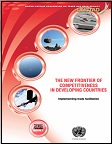 The New Frontier of Competitiveness in Developing Countries: Implementing Trade FacilitationThis report presents an overview of implementation challenges for realizing trade facilitation reforms. It consolidates results of 26 national trade facilitation implementation plans in 26 countries, comprising least developed countries, middle-income developing countries, landlocked countries, and small island economies in Africa, Asia, the Caribbean and Latin America. In the 26 countries surveyed, the level of implementation of trade facilitation measures in the World Trade Organization (WTO) is considerably lower in least developed countries (LDCs) than in developing countries. Since trade facilitation still remains a major challenge for developing countries and LDCs, an international legal regime with special and differential treatment will help developing WTO members achieve further progress. Author: United Nations Conference on Trade and Development Year: 2014 Download Tags: Trade Facilitation, Asia-Pacific, WTO, Bangladesh, Bhutan, Nepal Economic and Social Survey of Asia and the Pacific 2014This 2014 edition of UNESCAP's flagship publication emphasizes the importance of furthering regional connectivity in Asia-Pacific—a region which, despite significant reductions in poverty levels, is now witnessing rising income inequality, both within and between countries. It calls for driving the region's growth by exploiting the interdependence and synergies of five elements: trade and transport connectivity, ICT networks, energy connectivity, people-to-people networks, and promotion of knowledge-based economies, and advocates approaching connectivity as a regional public good. Author: UNESCAP Year: 2014 Download Tags: Economic Integration, Regional Cooperation, Poverty Reduction, Asia-Pacific, Connectivity, Energy, ICT, Bangladesh, Bhutan, India, Maldives, Sri Lanka, Trade, Transport, UNESCAP 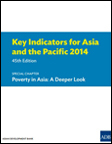 Key Indicators for Asia and the Pacific 2014This year's edition presents an in-depth inquiry on poverty in Asia, tackling whether the $1.25/day extreme poverty standard still accurately depicts minimum living standard of the poor in Asia and the Pacific. Using this broad measure, the poverty rate is projected to fall to 24.5% for South Asia by 2030, if recent economic growth trends continue. However, considering the current national poverty line average among today's less developed economies in the region, an Asia-specific extreme poverty line is more accurately estimated at $1.51/day, increasing Asia’s poverty rate in 2010 by 9.8%, and ��of a large economy like India by 15%. Hence, despite huge gains made, reducing poverty remains a pressing challenge in Asia and the Pacific. This book proposes several measures to counteract worsening poverty, including �close �regional cooperation which can reduce a country’s vulnerability, and urgent policy actions that promote economic growth and prioritize climate change adaptation and mitigation. Author: Asian Development Bank Year: 2014 Download Tags: Poverty Reduction, Disaster Risk, Regional Cooperation, Asia-Pacific, Bangladesh, Bhutan, Economics, Energy, India, Maldives, Milennium Development Goals, Nepal, Sri Lanka, Sustainability, Transport Assessing the Costs of Climate Change and Adaptation in South AsiaThis book discusses the economic costs and benefits of unilateral and regional actors on climate change adaptation in Bangladesh, Bhutan, India, the Maldives, Nepal, and Sri Lanka. It provides the total economic loss throughout the 21st century and estimates the funding required for adaptation measures to avert potential losses. Huge impacts are likely on vulnerable sectors in the region, with South Asia losing on average nearly 2% of its gross domestic product by 2050. Results of the study will aid climate change adaptation in the region, including initiatives for regional cooperation. Author: Mahfuz Ahmed and Suphachol Suphachalasai Year: 2014 Download Tags: Climate, South Asia, Regional Cooperation, Energy, Bangladesh, Bhutan, India, Maldives, Nepal, Sri Lanka 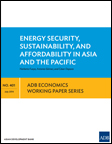 Energy Security, Sustainability, and Affordability in Asia and the PacificEnergy security, sustainability, and affordability from 2010 to 2035 for Asian Development Bank’s Asia and Pacific members are calculated in this working paper, including potential benefits of integrating energy systems regionally. Based on business-as-usual and alternative scenarios, outlook on SASEC member countries by 2035 include (i) dramatic improvement in Bhutan's energy efficiency, (ii) slight decrease in Bangladesh's energy intensity—although carbon dioxide will increase in its primary energy mix, as dependence on fossil fuels rise, and (iii) decrease in energy self-sufficiency of SASEC member countries by 2035, but improved energy affordability. Since renewable energy sources and importation of energy may be capital-intensive, requiring additional tariff support, regional cooperation can enhance affordability and energy security—with Bhutan and Nepal standing to benefit greatly from energy integration in South Asia. Author: Norberto Fueyo, Antonio Gómez, and César Dopazo Year: 2014 Download Tags: Energy, Bhutan, Nepal, Sustainability, Asia-Pacific, ADB, Regional Integration, SASEC, South Asia, Bangladesh, Sustainability, Renewables, Tariff, Regional Cooperation 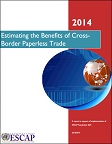 Estimating the Benefits of Cross-Border Paperless TradeCross-border paperless trade is trade that occurs on the basis of electronic communications and has been part of customs reform efforts in a variety of countries. Increased implementation of cross-border paperless trade is high on the trade facilitation agenda in Asia-Pacific. This report considers six measures to calculate estimates of possible economic benefits of cross-border paperless trade through counterfactual simulations using 2013 data and simple econometric models. Simulation results reveal that this new generation of trade facilitation can significantly reduce trade costs and boost intra- and extra-regional trade in the region. Partial implementation of these measures can lead to an export increase of $36 billion annually. Total direct cost savings across all trade is about $1 billion per annum for partial reform, and $7 billion for full implementation. Author: United Nations Economic and Social Commission for Asia and the Pacific Year: 2014 Download Tags: Trade Facilitation, Trade, Asia-Pacific, UNESCAP, Customs, Export, Bangladesh, Bhutan, India, Maldives, Nepal, Sri Lanka Green Power for Bhutan: Clean Energy Crosses Borders to Reach Poor HouseholdsConstructed under the ADB-financed Green Power Development Project, Bhutan's Dagachhu hydropower plant showcases how a public–private partnership for hydropower development successfully promotes cross-border energy trade, contributes to increased national energy security, and improves access to on- and off-grid energy for 9,000 rural households and public facilities. This report reviews the project's key features and discusses how an investment in renewable energy infrastructure is leading Bhutan and its neighboring countries toward greater inclusive growth. Author: Asian Development Bank Year: 2014 Download Tags: Energy, Infrastructure, Poverty Reduction, Bhutan, ADB RCI 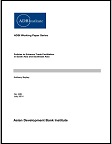 Policies to Enhance Trade Facilitation in South Asia and Southeast AsiaThis Asian Development Bank Institute publication identifies the state of play of trade facilitation and provides an overview of intra- and inter-regional trade in South and Southeast Asia. It highlights key challenges and bottlenecks to effective trade facilitation, ranging from the lack of expert human resources such as information technology specialists in small landlocked countries (Bhutan and Nepal), to the high border transaction costs and severe congestion faced at border crossing points, and the lack of effective dialogue on bilateral enhancement of trade facilitation. Regional initiatives such as the South Asia Subregional Economic Cooperation Program aim to address these challenges through customs modernization and harmonization, automation, and the use of international best practices in border procedures. Author: Anthony Bayley Year: 2014 Download Tags: South Asia, Trade Facilitation, Trade Policy, Southeast Asia, ADB, ICT, Bhutan, Nepal, SASEC, Customs 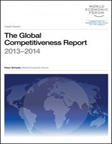 Global Competitiveness Report 2013-2014The World Economic Forum's Global Competitiveness Report offers a platform for dialogue among key stakeholders in government, business, and civil society on improving the living standards of the world’s citizens through insights on institutions, policies, and factors that drive or hinder growth and national competitiveness. Using the Global Competitiveness Index (GCI), twelve pillars are considered, including infrastructure, which, among factor-driven economies of Bangladesh, India, and Nepal, impacts the location of economic activity, reduces distance between regions, and enables production and faster flow of goods. Market size—essential for countries with small domestic markets—is another key index measured. The 2013-2014 report also includes an assessment of newly-covered Bhutan, and an analysis for the drop in India's GCI ranking. Author: Klaus Schwab Year: 2014 Download Tags: Economics, Poverty Reduction, Infrastructure, Bangladesh, Bhutan, Energy, India, Nepal, Sri Lanka, Transport Trade Facilitation and Paperless Trade ImplementationThis paper reports survey findings on progress in implementing various trade facilitation and paperless trade measures made by 29 countries in Asia and the Pacific, including six SASEC member countries. Factors considered include pre-arrival clearance, post-clearance audit, National Single Window, and authorized operator programmes. The survey reveals that while countries have prioritized automation and paperless trade at the regional level, there is an urgent need for regional arrangements that will facilitate cross-border exchange of trade-related electronic documents and information to enable smoother trade facilitation. Author: Tengfei Wang and Yann Duval Year: 2014 Download Tags: Trade Facilitation, Regional Cooperation, Trade, Asia-Pacific, SASEC, Single Window, UNESCAP, Customs, Bangladesh, Bhutan, India, Maldives, Nepal, Sri Lanka 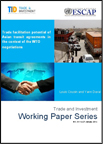 Trade Facilitation Potential of Asian Transit Agreements in the Context of the WTO NegotiationsFreedom of transit is an issue critical to landlocked developing countries whose lack of direct access to the sea has increased costs and lessened their competitiveness in international trade. To meet challenges arising from transit barriers, member states of the United Nations Economic and Social Commission for Asia and the Pacific recommend transit facilitation as part of an integrated approach to trade facilitation.
This working paper analyzes freedom of transit and transit facilitation in the context of trade and transport agreements in the Asia Pacific region, identifying good practices and weighing in on the extent to which existing agreements meet the provisions on transit facilitation stated in the draft text of the World Trade Organization Agreement on Trade Facilitation. Author: Louis Cousin and Yann Duval Year: 2014 Download Tags: Transport Facilitation, Trade Facilitation, WTO, Asia, UNESCAP, Bangladesh, Bhutan, India, Nepal Together We Deliver: 10 Stories from ADB-Supported Projects Together We Deliver showcases ten ADB projects across Asia and the Pacific that demonstrate clear development impacts, replicable best practices, and valuable use of innovation. Among those highlighted is SASEC's Green Power Development Project in Bhutan, which is boosting the national economy through clean energy exports to India and also funding social programs that bring electricity to more than 8,500 rural poor households. The book also features a rural road project in India that connects remote communities to schools, hospitals, and other facilities. Capturing a wide range of ADB's assistance, the book portrays how ADB is changing for better the lives of many in Asia and the Pacific region. Author: Asian Development Bank Year: 2014 Download Tags: Regional Cooperation, Bhutan, India, Development, Energy Asian Development Outlook 2014: Fiscal Policy for Inclusive GrowthThe Asian Development Outlook, ADB’s flagship economic publication provides comprehensive macroeconomic analysis in Asia including growth projections by country and region. The Asian Development Outlook 2014 forecasts that developing Asia will grow 6.2% in 2014 and 6.4% in 2015. South Asia remains one of the slowest growing subregions—although growth is forecast to improve by 5.3% in 2014 and 5.8% in 2015. Author: Asian Development Bank Year: 2014 Download Tags: ADB, Bangladesh, Bhutan, Economic Corridor, Energy, India, Maldives, Nepal, Sri Lanka, Transport 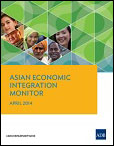 Asian Economic Integration Monitor - April 2014The Asian Economic Integration Monitor, a semiannual review of regional economic cooperation and integration in Asia covers regional economic updates, intraregional trade, financial integration and investment, and the importance of disaster risk financing instruments. The Theme Chapter: Insuring Against Asia’s Natural Catastrophes discusses market solutions and the role of government in developing disaster risk financing and strengthening financial resilience. The economic update section encourages strengthening regional cooperation in surveillance and financial safety nets, and deepening economic links. Inter-subregional trade between each subregion and the rest of Asia is rising, except in South Asia, while financial integration continues to deepen across the region. Author: Asian Development Bank Year: 2014 Download Tags: Regional Cooperation, Regional Integration, South Asia, Disaster Risk, Climate, Bangladesh, Bhutan, India, Maldives, Nepal, Sri Lanka, Transport Asian Market Development and Integration: Challenges and OpportunitiesThis book, co-published by Asian Development Bank (ADB) and Korea Capital Market Institute (KCMI), in collaboration with the Peterson Institute for International Economics, examines the path of capital market development in Asia since the 2008 global crisis. It presents the analytical framework for addressing capital market integration at the regional level and its likely impacts. Author: Asian Development Bank (ADB) and Korea Capital Market Institute(KCMI), eds. Year: 2014 Download Tags: Economics, Trade Policy, Regional Integration, Bangladesh, Bhutan, India, Maldives, Nepal, Sri Lanka South Asia Energy Security: Challenges and OpportunitiesThe imbalance between the growing demand for energy in South Asia and the countries' uneven energy resources has led to weakened energy security in the region. Import dependence from outside the region has become a costly solution. As countries in South Asia move to expand their economies, fostering cross border energy trade and promoting energy investment opportunities could be a better alternative to resolving the energy deficit. However, energy cooperation within South Asia is challenged by major issues that could impede regional energy trade that is beneficial for all. Author: Bhupendra Kumar Singh Year: 2013 Download Tags: Energy, South Asia, Bangladesh, Bhutan, India, Nepal, Pakistan, Sri Lanka, Trade, Hydropower Reducing Poverty by Closing South Asia's Infrastructure GapThis report takes a critical look at inter-and intra-regional infrastructure of South Asia and explores inequality of access across space and time. It gives an approximate total cost of regional infrastructure needs and investment trends in the South Asia region, along with a proposed framework on ranking of infrastructure needs. The report also examines better usage of existing resources and policy options to help the poorest gain better access to infrastructure.
Finally, it recognizes the enormity of infrastructure deficiencies in South Asia and acknowledges that a good mix of infrastructure investment and supportive reform implementation will enable the region to close the infrastructure gap. Author: Luis Andrés, Dan Biller, and Matías Herrera Dappe Year: 2013 Download Tags: Transport, South Asia, Infrastructure, Energy, Roads, Railway, Water Supply, Bangladesh, Bhutan, Nepal, India, Sri Lanka, Maldives ADB Regional Cooperation Operations Business Plan (RCOBP) 2014-2016 for South AsiaADB's third Regional Cooperation Operations Business Plan (RCOBP) 2014-2016 for South Asia under its South Asia Regional Cooperation Strategy (RCS) 2011-2015 details a cumulative indicative lending program of $3.3 billion and maintains focus on improved regional connectivity, increased cross-border trade, and strengthened regional economic cooperation. Author: Asian Development Bank Year: 2013 Download Tags: Regional Cooperation, Regional Integration, Bangladesh, Bhutan, India, Maldives, Nepal, Sri Lanka, Trade Facilitation, Transport, Energy, SAARC Financing Low-Carbon UrbanDevelopment in South Asia: A Post-2012 Context The cities of South Asia are growing at an unprecedented rate. Currently, the region
accounts for 5 of the world's 26 megacities (Delhi, Dhaka, Karachi, Kolkata, and
Mumbai),with Kolkata and Mumbai being the most dense. The urban population in
India is expected to increase by 20.8 percentage points between 2010 and 2050 compared
to 7.8 percentage points in Latin America and the Caribbean. These trends necessitate bold
efforts in project design and financing to steer this rapid urbanization onto an inclusive, green,
and low-carbon urban development path. Author: Asian Development Bank Year: 2013 Download Tags: Climate, Energy, India, South Asia, Kyoto Protocol, Bangladesh, Bhutan, Nepal, India, Maldives, Sri Lanka Bhutan Critical Development ConstraintsBhutan 2020: A Vision for Peace, Prosperity and Happiness embodies the development philosophy
of His Majesty King Jigme Singye Wangchuck and sets out directions that will enable Bhutan to
execute this philosophy while at the same time retaining its commitment to its distinctive model
of harmonious and balanced development. Author: Asian Development Bank / Australian Government / Japan International Cooperation Agency Year: 2013 Download Tags: Bhutan, Development Aid for Trade: An Investment Benefit Road Map for South AsiaAid for Trade (AfT) came to prominence just over a decade ago at the launch of the
World Trade Organization's Doha Round. With its focus on helping least developed
countries and economies escape the poverty trap, it aims to strengthen their
capabilities to meet market demand and to reduce supply-side constraints such as a lack of
trade infrastructure. Author: Asian Development Bank Year: 2013 Download Tags: Trade Policy, Poverty Reduction, Infrastructure, India, Bangladesh, Bhutan, Maldives, Sri Lanka, Nepal, Trade Facilitation, Transport, Global Value Chains, Exports Energy Outlook for Asia and the Pacific: October 2013The Energy Outlook for Asia and the Pacific aims to support ADB energy sector operations
by providing stakeholders with an energy outlook for the region up to the year 2035.
It attempts to identify policy, social, infrastructure, and technology issues that must be
addressed to meet future energy need of ADB members in Asia and the Pacific. Author: Asian Development Bank Year: 2013 Download Tags: Energy, Infrastructure, Renewables, Hydropower, Transport, Bangladesh, Bhutan, India, Nepal, Maldives, Sri Lanka Climate Action South Asia: Information Update No. 3 (The Economics of Climate Change in South Asia: Adaptation and Impact Assessment)Analyses show that the cost of early action on climate change in South Asia is lower than
the cost of damage brought about by climate change impacts. In physical terms, the region
will face water shortage and agricultural food production losses, which are vital to achieving
poverty reduction and other Millennium Development Goals (MDGs). Author: Asian Development Bank Year: 2013 Download Tags: Economics, Climate, Agriculture, Climate Change, Environment, South Asia, Milennium Development Goals, Sustainability, Bangladesh, Bhutan, India, Nepal, Maldives, Poverty Reduction, Hydropower, Energy Climate Action South Asia: Information Update No. 2 (Economics of Reducing Greenhouse Gas Emissions in South Asia: Options and Costs)The study Economics of Reducing Greenhouse Gas Emissions: Options and Costs in Bangladesh, Bhutan, the Maldives, Nepal, and Sri Lanka reveals excellent opportunities in low-carbon green growth by pursuing resource- and energyefficient technologies that would lower emissions of greenhouse gases at low cost or even cost saving (benefits). Author: Asian Development Bank Year: 2013 Download Tags: Economics, Climate, Climate Change, Economics, South Asia, Bangladesh, Bhutan, Maldives, Sri Lanka, Energy, Environment, Sustainability, ADB, Nepal, Development, Hydropower 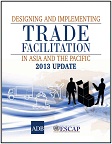 Designing and Implementing Trade Facilitation in Asia and the PacificThis reference book was published to support the implementation of trade facilitation measures and reforms in Asia and the Pacific. It includes operational guidance on assessing the status of trade facilitation, the measures and reforms needed, how to design trade facilitation initiatives, and how to implement them at national and regional levels. The book is intended to assist policy makers, practitioners, and economists by bridging the gap between theory and practice. The revised 2013 version includes updated statistical figures and data, information on actual trade facilitation policies and practices, and the most recent research on trade facilitation. Author: Asian Development Bank / United Nations Economic and Social Commission for Asia and the Pacific Year: 2013 Download Tags: Trade Facilitation, Regional Cooperation, Regional Integration, Trade Policy, Economic Corridor, Sanitary and Phytosanitary Measures, Technical Barriers to Trade, Revised Kyoto Convention, Customs, Customs Valuation, Bangladesh, Bhutan, India, Nepal, Maldives, Sri Lanka, Services Asia-Pacific Trade Facilitation Forum: Survey on Trade Facilitation and Paperless TradeConducted jointly by the Asian Development Bank and the United Nations Economic and Social Commission for Asia and the Pacific, this survey provides a status snapshot of trade facilitation in place across 26 countries of the region, including progress towards establishment of national trade facilitation committees, implementation of risk management measures, development of national single windows, and steps taken to move toward paperless trade. It further examines specific issues and challenges in these areas of South East Asian countries, and provides recommendations for improvement. Author: ADB and UNESCAP Year: 2012 Download Tags: Trade Facilitation, Paperless Trade, Bangladesh, Bhutan, India, Nepal, Maldives, Sri Lanka, Customs, Transport Facilitation, Myanmar, National Single Window Regional Integration and Economic Development in South AsiaSouth Asian leaders have made it a priority to tackle key regional issues such as poverty, environment degradation, trade and investment barriers and food insecurity, among others. This book considers the leadership of the South Asian Association for Regional Cooperation (SAARC) and the interaction with civil society in the process of South Asian regional cooperation and integration, and discusses how the emerging urgency in the provision of regional public goods provides an excellent opportunity to add to the successes in South Asian regional integration. Author: Sultan Hafeez / Rahman Sridhar Khatri / Hans-Peter Brunner Year: 2012 Download Tags: Economic Corridor, Regional Cooperation, Regional Integration, SAARC, SAFTA, Bangladesh, Bhutan, India, Maldives, Nepal, Sri Lanka Sector Roadmaps with Result FrameworksSector roadmaps with result frameworks for transport, energy, and trade facilitation. Author: Asian Development Bank Year: 2011 Download Tags: Trade Facilitation, Energy, Transport, Bangladesh, Bhutan, India, Maldives, Nepal, Sri Lanka Regional Cooperation and Integration Through Cross-Border Insfrastructure Development in South AsiaThis paper aims to identify the links between cross-border infrastructure development and poverty reduction. With South Asia being home to around 40% of the world's poor, there is a great need to boost intraregional trade through greater cooperation and integration. Regional integration promises to increase the region's capacity to connect with global production networks and participate in the global economy with greater efficiency. Author: P.V. Srinivasan Year: 2011 Download Tags: Regional Cooperation, Regional Integration, South Asia, Bangladesh, Bhutan, India, Maldives, Nepal, Sri Lanka, Poverty Reduction South Asia- Intra Regional Cooperation: The Way ForwardThis study aims to showcase the benefits of regional integration and recommends strategies for overcoming the many hurdles. Author: Shahid Kardar Year: 2011 Download Tags: Policy, Economic Cooperation, Regional Integration, Development, SAARC, Non-Tariff Measures, Trade Facilitation, SAFTA, India, Bangladesh, Bhutan, Maldives, Nepal, Sri Lanka, BIMSTEC, Myanmar, SASEC, Energy 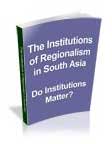 The Institutions of Regionalism in South Asia - Do Institutions Matter?This paper assesses the contribution of key institutions of regional cooperation and integration (RCI) in South Asia, and suggests ways in which the Asian Development Bank and other development partners can strengthen their support. It attempts to enhance understanding on the interplay between politics and RCI, including how good bilateral political relations or improvements have advanced RCI. With the overall political environment growing increasingly open to RCI, the paper suggests the time has come for the South Asian Association for Regional Cooperation (SAARC) to consider strengthening the capacity of the SAARC Secretariat to meet the growing challenges and work load of managing the anticipated increase in RCI. Author: Prabhu Ghate Year: 2011 Download Tags: Regional Cooperation, Regional Integration, Development, SAARC, Trade, Services, Trade Facilitation, Energy, Free Trade Agreements, SAFTA, Bangladesh, Bhutan, India, Maldives, Nepal, Sri Lanka, Transport Energy Trade in South Asia: Opportunities and ChallengesThe South Asia Regional Energy Study was completed as an important component of the regional technical assistance project Preparing the Energy Sector Dialogue and South Asian Association for Regional Cooperation Energy Center Capacity Development. It involved examining regional energy trade opportunities among all the member states of the South Asian Association for Regional Cooperation. The study provides interventions to improve regional energy cooperation in different timescales, including specific infrastructure projects which can be implemented during these periods. Author: Sultan Hafeez Rahman / Priyantha D. C. Wijayatunga / Herath Gunatilake / P. N. Fernando Year: 2011 Download Tags: Energy, Regional Cooperation, Regional Integration, SAARC, Trade, Bangladesh, Bhutan, India, Nepal, Maldives, Sri Lanka The Provision of Regional Public Goods in South AsiaThis report reviews the provision of high priority regional public goods (RPGs) selected
for the South Asia subregion, and proposes areas of cooperation for improving the provisioning of RPGs in South Asia. It highlights the issues in cross border management of infrastructure projects and best practices in the provisioning of RPGs relevant for South Asia, evaluates ADB’s contributions to providing RPGs in the subregion, and concludes with recommendations on ADB’s South Asia Regional Department’s role in the provision of RPGs in the subregion. Author: Khaja Moinuddin Year: 2010 Download Tags: Energy, Agriculture, Disaster Risk, Governance, Poverty Reduction, Bangladesh, Bhutan, India, Maldives, Nepal, Sri Lanka, Trade Facilitation, Transport Binding Contraints to Regional Cooperation and Integration in South AsiaThis paper examines the benefits of regional cooperation and integration, focusing on the cost of neglecting to address the binding constraints to regional cooperation and integration. Component papers in this volume analyze the current state of play, and identifies the binding constraints to achieving more efficient transport corridors, regional energy trade and trade facilitation in the region. Author: Gilberto M. Llanto Year: 2010 Download Tags: Regional Cooperation, Economic Integration, Trade Facilitation, Energy, Bangladesh, Bhutan, India, Maldives, Nepal, Sri Lanka, Transport Infrastructure for a Seamless AsiaThe study reviews regional infrastructure being enhanced through regional cooperation in Asia and examines major issues and challenges. It suggests a framework for pan-Asian infrastructure cooperation, anchored on a long-term vision of creating a seamless Asia that will not only enhance the region's competitiveness and extend its global reach, but also help reduce poverty and promote greater environmental sustainability. Author: Asian Development Bank / Asian Development Bank Institute Year: 2009 Download Tags: Regional Cooperation, Regional Integration, Transport, Trade Facilitation, Connectivity, India, Bangladesh, Bhutan, Nepal, Maldives, Sri Lanka, Asian Highway, Trans-Asian Railway Network, Energy, Myanmar Quantification of Benefits from Economic Cooperation in South AsiaThe study examines the implication of the South Asian Free Trade Agreement (SAFTA) on South Asian countries and on the region as a whole, employing both a quantitative and qualitative assessment on the outcomes of SAFTA. The research aims to provide support in the formulation of concrete policy measures for trade to ensure greater gains for the region, while at the same time mitigating potential negative impacts. Economic and social assessments through analytical tools and rational causal chain analysis further enrich the study. Author: Asian Development Bank / United Nations Conference on Trade and Development Year: 2008 Download Tags: Economic Corridor, Regional Cooperation, Regional Integration, SAFTA, Free Trade Agreements, Trade Facilitation, Transport, Services, SAARC, Bangladesh, Bhutan, India, Maldives, Nepal, Sri Lanka Emerging Asian Regionalism-A Partnership for Shared ProsperityThe study summarizes important issues related to Asian regionalism. Viewing regional cooperation as a necessary tool for coping with the consequences of interdependence, the book discusses several pressing issues, such as integrating production, improving financial cooperation, and managing macroeconomic interdependence to create a stable architecture for an Asia-wide cooperation. Author: Asian Development Bank Year: 2008 Download Tags: Economic Corridor, Regional Cooperation, Regional Integration, Asia, ASEAN, SAARC, Bangladesh, Bhutan, India, Nepal, Maldives, Sri Lanka SASEC ICT Development Master PlanThis report represents the first comprehensive multilateral ICT development plan. Its primary objective is to create a framework that will support the already existing ICT plans of Bangladesh, Bhutan, India, and Nepal and help these SASEC countries collaborate more effectively with each other. Author: Asian Development Bank Year: 2006 Download Tags: ICT, Regional Cooperation, Regional Integration, SASEC, Bangladesh, Bhutan, India, Nepal |



